Birds & Birders in the Urban Forest
![]()
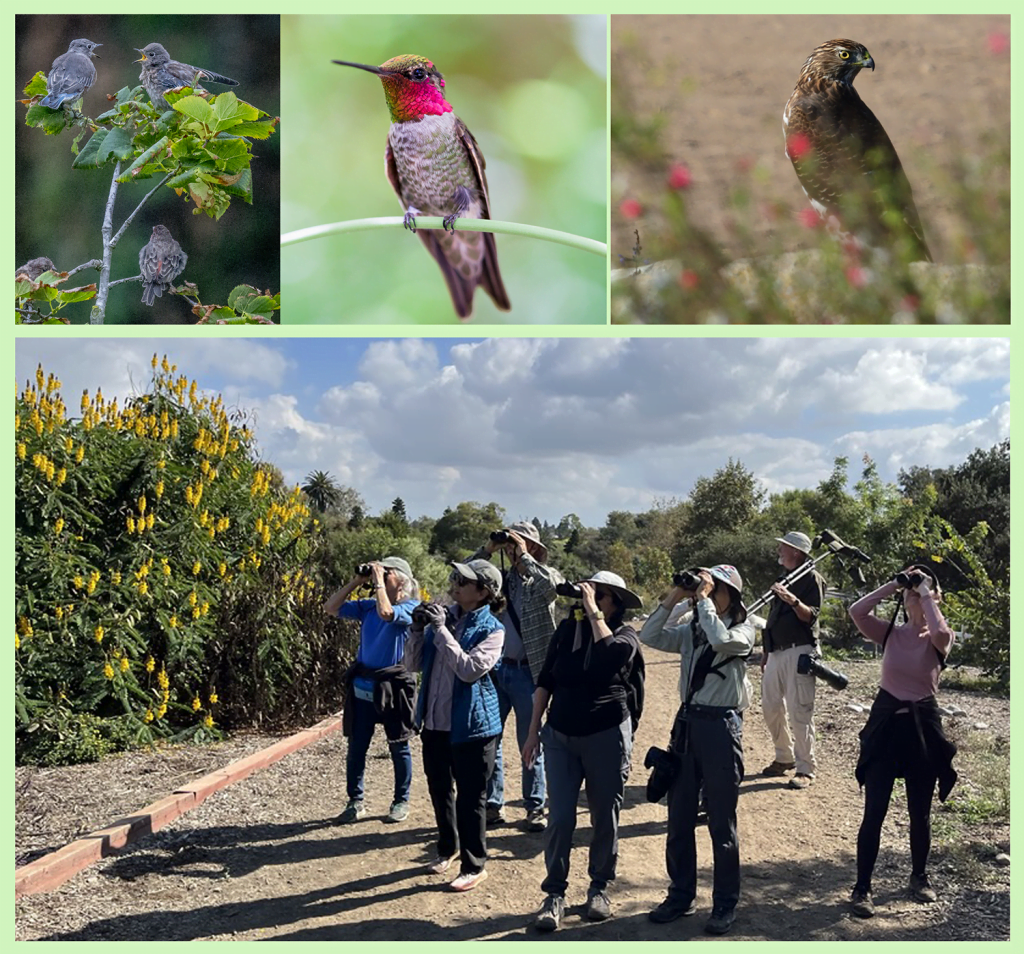
Since September 2020 on the last Thursday of each month, birding enthusiasts descend upon the Urban Forest. They use an application called eBird, managed by the Cornell Lab of Ornithology, to count all birds they spy during their visit. Here’s what the eBird website says about the impact their efforts have:
“eBird plays an increasingly important and diverse role in applied science and conservation. eBird data contribute to hundreds of conservation decisions and peer-reviewed papers, thousands of student projects, and help inform research worldwide. Applications of eBird data range from research and monitoring to conservation planning, including tangible conservation actions such as site and habitat management, species management, habitat protection, and informing law and policy … we are committed to ensuring that your data will be put to the best use possible for research, conservation, and education.
“eBird data document bird distribution, abundance, habitat use, and trends. Birders enter when, where, and how they went birding, and then fill out a checklist of all the birds seen and heard during the outing.”
Boundaries of the HB Urban Forest survey are: HB Central Park Dog Park and equestrian stables to the north, Edward’s to the east, Ellis Avenue to the south and Goldenwest Street to the west. Bird reports are submitted by lead birder Lena Hayashi.
APRIL BIRD OF THE MONTH:
RED-TAILED HAWK
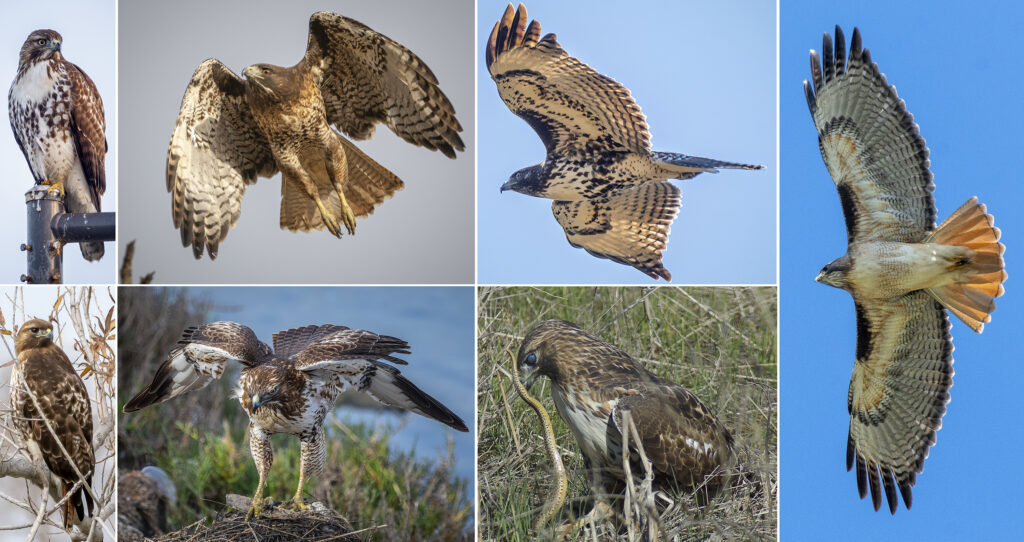 Photos by James Kendall. Essay by Betty Kanne. |
The Red-tailed Hawk is one of the most conspicuous and widespread large birds of prey in North America. If you spot a big solitary raptor perched high in erect posture along a roadside or field edge, it’s quite likely a Red-tailed Hawk. It thrives in open woodlands and fields where it can be seen lazily soaring in a circular pattern riding the upward thermals while keenly watching the ground for rodents, rabbits, lizards or other scurrying prey that comprise its carnivorous diet. Immediately upon sighting prey while circling as high as 100 feet in the air, the Red-tailed Hawk “stoops”, folding its wings, entering into a high speed aerial dive, seizing the unwitting target at high velocity impact with its lethally powerful talons.
They may also employ a patient, vigilant hunting technique as they perch silently atop trees, telephone poles, or building edges, keenly surveying their hunting grounds, poised and ready to strike suddenly when likely prey appears. The hawk’s eyesight is eight times more powerful than that of a human.
Its well recognized haunting call is a hoarse, rasping scream that has routinely served as the iconic desolate soundscape in Western cowboy movies for generations.
Red-tail Hawks typically mate for life and the pair carefully craft a sturdy nest of sticks high in a leafy treetop where the substantially larger female lays and incubates 2-4 eggs carefully tended by both parents until successfully fledged 4-6 weeks after hatching. Juvenile hawks will continue to stay close to the nest to be aided by their attentive parents for another two months before achieving full independence as a reliably capable hunter.
Adult red-tailed hawks have few predators, but Great Horned Owls and crows readily prey on Red-tailed Hawk eggs and nestlings. Under favorable circumstances they can be expected to live an average of twenty years in the wild.
Red-tailed hawks are considered symbols of strength, courage, and wisdom in Native American folklore and are often heartily welcomed as harbingers of good fortune.
MARCH BIRD OF THE MONTH:
GREAT HORNED OWL
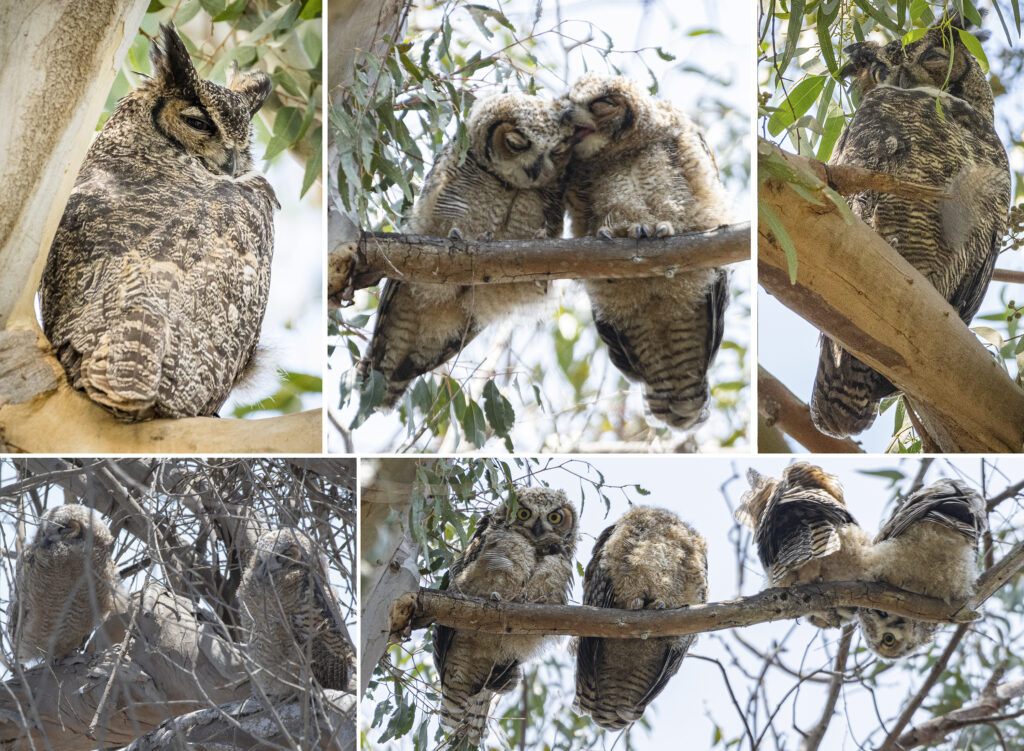 Owls and their owletts, observed in Huntington Central Park. Photos by James Kendall. Story by Betty Kanne. |
The Great Horned Owl is a habitually successful, resident breeding bird species in Huntington Central Park. Multiple groves of mature trees and open foraging areas provide an ideal habitat for these highly secretive nocturnal birds of prey.
Great Horned Owls, like many raptors, are thought to be monogamous and mate for life. The distinctive, low, deep hooting of both males and females is primarily heard nighttime from December through February when the bonded pairs are engaging in a lot of vigorous hooting as they establish territories and court. Like most raptors, Great Horned Owls are early nesters and will lay their eggs from mid-February until late March, before most other birds have even established territories.
Opportunistically, these owls simply reuse an old nest of a hawk or other large bird. They can also nest in natural tree hallows, stumps, or abandoned structures. While the male does the hunting for food while the female sits on the eggs, both parents will feed the babies after they hatch.
The Great Horned Owl is nocturnal, but is occasionally actively hunting in the late afternoon or early morning. Even though they are fairly large birds, their soft feathers and special wing structure makes them able to fly swiftly and silently. They have excellent night vision; but because their enormous golden eyes can’t move in their sockets they must rotate their heads in order to look around and can pivot up to 270 degrees.
This large barrel shaped owl stands up to 24” tall and has two high or peaked feather groupings on the top of its head, which may resemble horns or possibly ears, but they are neither. Their concealed ear openings are further down on the sides of their heads and like many owls, one ear is lower than the other. The asymmetrical ear placement was adapted to improve their highly acute hearing, aiding to accurately pinpoint prey location. Extraordinary vision and hearing along with stealthy silent flight and powerful, sharp talons make the Great Horned Owl a skillfully lethal hunter. Their diet of mammals, primarily rodents helps to keep rat, mouse, squirrel and rabbit populations in check within our city parks.
With care, you can personally view one of these camouflaged birds of prey hidden within in our park. When walking under our soaring, mature trees keep an attentive eye on the ground looking for tiny owl pellets (small regurgitated balls of indigestible bones and fur) that are coughed up daily by the Great Horned Owls concealed in the dense branches directly overhead as they perch in rest during daylight hours preparing for their nighttime hunt.
Raptor Foraging Area – A designated Raptor Foraging Area has been identified and is being enhanced on the hilltop area adjacent to the Urban Forest. This marked, designated area has been set aside in a mitigation agreement in order to provide suitable habitat for a variety of birds of prey dependent upon natural open field foraging with drought tolerant CA native plants suited to their survival needs.
Huntington Central Park, with its 50-year history, continues to be host to a variety of raptors/birds of prey including hawks, falcons, owls, vultures and eagles. We will continue to feature selected descriptions of the dozen or more that have been counted in our park.
Observations
-
Number observed: 2
-
Number observed: 4
© James Kendall Macaulay Library -
Number observed: 20
-
Number observed: 1
© James Kendall Macaulay Library -
Number observed: 4
-
Number observed: 8
© Lena Hayashi Macaulay Library © James Kendall Macaulay Library © James Kendall Macaulay Library -
Number observed: 18
-
Number observed: 4
-
Number observed: 8
-
Number observed: 2
-
Number observed: 2
-
Number observed: 1
-
Number observed: 3
© James Kendall Macaulay Library -
Number observed: 4
-
Number observed: 6
-
Number observed: 1
-
Number observed: 23
-
Number observed: 2
-
Number observed: 38
© Lena Hayashi Macaulay Library © James Kendall Macaulay Library -
Number observed: 12
-
Number observed: 4
-
Number observed: 1
-
Number observed: 28
-
Number observed: 1
-
Number observed: 6
© Lena Hayashi Macaulay Library © Lena Hayashi Macaulay Library © Lena Hayashi Macaulay Library © James Kendall Macaulay Library © James Kendall Macaulay Library -
Number observed: 1
-
Number observed: 50
-
Number observed: 18
© Lena Hayashi Macaulay Library © James Kendall Macaulay Library -
Number observed: 3
© Lena Hayashi Macaulay Library © James Kendall Macaulay Library -
Number observed: 8
-
Number observed: 13
-
Number observed: 8
© James Kendall Macaulay Library -
Number observed: 5
© Lena Hayashi Macaulay Library © James Kendall Macaulay Library © James Kendall Macaulay Library -
Number observed: 2
© Lena Hayashi Macaulay Library -
Number observed: 1
-
Number observed: 2
© James Kendall Macaulay Library -
Number observed: 5
© James Kendall Macaulay Library © James Kendall Macaulay Library -
Number observed: 5
-
Number observed: 2
-
Urban Forest Monthly Survey
February 2023
42 Species, 272 Individuals
On this Leap Year Day, Lena Hayashi, Betty Kanne (eBird), Jim Kendall, Ellen Tipping, and Dave and Sharon Telford counted all the birds they could hear and see in the Urban Forest.
The weather was in the 50s to mid-60s. Mostly overcast and calm with sunlight in and out at the end of the survey.
The Western Meadowlarks were well hidden in the grassland area for raptor foraging. Though we were sure there were more, we only counted 21 as they flew out only to disappear again 20 yards further away. The most vocal of all the species was the House Wren. They were singing from every direction and scolding sounds were also heard. Orange-crowned Warblers were trilling their full songs as were the Song Sparrows and Common Yellowthroat Warblers. It was interesting that we saw and heard more American Goldfinches than Lesser Goldfinches. With the rain we have already received, the sycamore trees should be producing abundant seed pods for the goldfinches this spring and summer.
Whether it was the cold, overcast skies, or the early morning time, we did not see the Northern Parula that was reported later in the day. We also were disappointed in the small number of Hermit Thrushes, Ruby-crowned Kinglets, and White-crowned Sparrows.
Below are the species and their numbers. Click on the name of the bird, printed in blue, to open with more information from the Cornell Lab of Ornithology, including what sounds the bird makes and its status and distribution.
-
Number observed: 4
-
Number observed: 2
-
Number observed: 6
-
Number observed: 5
-
Number observed: 2
-
Number observed: 7
© James Kendall Macaulay Library -
Number observed: 15
-
Number observed: 2
-
Number observed: 2
-
Number observed: 1
-
Number observed: 2
© Lena Hayashi Macaulay Library © James Kendall Macaulay Library © James Kendall Macaulay Library -
Number observed: 1
© James Kendall Macaulay Library © James Kendall Macaulay Library -
Number observed: 1
-
Number observed: 1
-
Number observed: 1
-
Number observed: 3
-
Number observed: 2
© James Kendall Macaulay Library -
Number observed: 2
-
Number observed: 18
-
Number observed: 2
-
Number observed: 1
-
Number observed: 10
-
Number observed: 4
-
Number observed: 1
-
Number observed: 16
© James Kendall Macaulay Library -
Number observed: 9
-
Number observed: 1
-
Number observed: 6
© James Kendall Macaulay Library -
Number observed: 1
-
Number observed: 42
-
Number observed: 6
-
Number observed: 10
© James Kendall Macaulay Library -
Number observed: 7
-
Number observed: 12
-
Number observed: 4
© James Kendall Macaulay Library -
Number observed: 2
-
Number observed: 21
-
Number observed: 8
-
Number observed: 1
-
Number observed: 8
-
Number observed: 5
-
Number observed: 18
FEBRUARY BIRD OF THE MONTH:
BALD EAGLE
 Photos of local Bald Eagles captured by James Kendall. Essay by local birder and HB Trees supporter Betty Kanne. |
As the national symbol of the United States, the awe inspiring adult Bald Eagle is one of the most recognized birds throughout its vast range of North America. Despite its distinctive appearance and impressive size it was nearly driven to extinction in the lower 48 states by the mid 1900’s due to the use of pesticides, particularly DDT which rendered the species incapable of successful reproduction. The passage of The Endangered Species Act of 1973 and the banning of DDT allowed for a partial rebound of the species in areas of the county that still provide soaring old-growth forests near large bodies of fresh water suitable for their nesting requirements with ready access to abundant fish, their preferred diet.
It takes four years for the young Bald Eagle to attain its characteristic adult appearance of a white head, white tail and starkly contrasting dark chocolate brown body. An enormous, hooked yellow bill, powerful yellow talons and piercing yellow eyes round out its fierce, commanding appearance. With a wingspan of nearly eight feet, a Bald Eagle makes an unforgettable impression. The formidable female is an impressive 25% larger than her male counterpart.
The densely populated, urban development of coastal Southern California provides a generally inhospitable habitat for a Bald Eagle. Yet to the surprised delight of Orange County observers, we have noted one or two young Bald Eagles intermittently appearing in our community over the last few winter seasons.
Although an adult breeding pair forms a solid, life-long monogamous bond, the first four to five years of life are frequently a time for solo roaming, often to great distances from the fledged nest site. The immature bird’s mottled brown body with splotches of white indicates its sub-adult status as does its penchant for wandering quite far from range. It is not unusual to see the presumably same individual return in subsequent winters, even into its full maturity. Reaching adulthood, the compelling need and challenging task of finding a mate may ultimately dictate its wandering back towards the area it was born. As rapt observers we can only speculate and remain hopeful for best outcomes for the wandering visitor on its perilous life journey.
Urban Forest Monthly Survey
January 26, 2024
42 Species, 450 Individuals
Unexpected rain didn’t stop the six volunteers who showed up this rainy morning. Five of us crowded into Lena’s car while Jim Currie stayed dry in his vehicle. We were all confident the rain would stop, and it only set us back 15 minutes. Wet and muddy, occasionally drizzly, it was dark and overcast until the last half an hour of the survey.
The surveyors were Lena Hayashi, Betty Kanne (eBird), Jim Kendall, Sharon Telford, Jim Currie, and Brian Bleeker, joining us for the first time.
It was quiet initially but as the sky brightened, the birds started calling and singing. Despite the cold and dampness, we were able to count 42 species of birds.
It is worthy to note that four of the species were raptors; an immature Cooper’s Hawk, a mature Red-shouldered Hawk, a mature Red-tailed Hawk, and a female American Kestrel. When the Senior Center was built in 2016 on open space land, compensation for the environmental impact on raptors led to the designation of the grassland hill of the Urban Forest for raptor foraging and perching. Spotting raptors is always a favorite not only for bird surveyors but for the public. Many may not know the names of the raptors but because of their size and the open space habitat, they are easily seen and appreciated. There is no doubt that the Great-horned Owls, for years notoriously known and seen by many through the windows of Huntington Central Library and from the trail below, forage on the hill at night for rodents and other prey.
Below are the species and their numbers. Click the checklist below to enjoy photographs taken by the photographers. Once online, you can also click the name of the bird, printed in blue, to open with more information from the Cornell Lab of Ornithology including what sounds the bird makes and its status and distribution.
Observations
-
Number observed: 5
-
Number observed: 25
-
Number observed: 15
-
Number observed: 1
-
Number observed: 2
-
Number observed: 6
© Lena Hayashi Macaulay Library -
Number observed: 19
-
Number observed: 1
-
Number observed: 1
-
Number observed: 1
© Lena Hayashi Macaulay Library © Lena Hayashi Macaulay Library -
Number observed: 1
-
-
Number observed: 2
-
Number observed: 1
© Lena Hayashi Macaulay Library -
Number observed: 6
-
Number observed: 2
© Lena Hayashi Macaulay Library -
Number observed: 1
-
Number observed: 1
-
Number observed: 30
-
Number observed: 51
-
Number observed: 15
-
Number observed: 4
-
Number observed: 3
-
Number observed: 10
© Lena Hayashi Macaulay Library -
Number observed: 5
© Lena Hayashi Macaulay Library © Lena Hayashi Macaulay Library -
Number observed: 5
-
Number observed: 6
-
Number observed: 63
© Lena Hayashi Macaulay Library -
Number observed: 10
-
Number observed: 3
-
Number observed: 1
© Lena Hayashi Macaulay Library -
Number observed: 16
-
Number observed: 17
© Lena Hayashi Macaulay Library © Lena Hayashi Macaulay Library -
Number observed: 7
-
Number observed: 2
-
Number observed: 12
-
Number observed: 60
-
Number observed: 1
-
Number observed: 2
-
Number observed: 4
-
Number observed: 3
-
JANUARY BIRD OF THE MONTH:
American Crow

Photos by James Kendall; essay by Betty Kanne
The loud, distinctive CAW! CAW! CAW! of the American Crow is a familiar year-round sound echoing across our wide continent in farm, field, and urban areas. Crows are considered to be among the most intelligent of birds, with their remarkably large brains and observably clever behaviors. Their widespread abundance serves as a valid testimony to their flexibility and adaptability leading to continued success in highly diverse climates and in ever challenging, shifting situations.
Like humans, American Crows are omnivores. Crows can exploit an immense array of food opportunities including insects, spiders, snakes, caterpillars, shellfish, fruit, berries, along with carrion, garbage and even the young of other birds or rodents. Opportunistic foragers, they quickly adapt to novel food sources, cleverly leveraging their prodigious intellect to discover new forms of nutrition. They scavenge along roadsides and garbage dumps where they often shrewdly use crude tools to successfully penetrate vexing yet appealing products. An acquired affinity for Cheetos and discarded french fries numbers among their most effective urban adaptations. Additionally, they have been observed skillfully carrying hard-shelled mollusks high into the air in order to drop the shell on rocks in order to break them, thus revealing their tasty treasures.
Holding a grudge! The crow’s remarkable intelligence and has been demonstrated by an astonishing ability to recognize individual humans and to astutely associate that person with a prior good or bad experience. The crow may characterize the individual as a “friend” or “foe” and then go on to overtly communicate that opinion to other crows within their social circle. The person deemed to be a “foe” will be relentlessly vocally harassed by the whole flock. Conversely, a person considered to be a “friend” may in fact receive gifts of small shiny trinkets as a reward for their perceived kind behavior.
The common large black American Crow is readily recognizable and needs scant introduction. Yet it is worth noting that a side-by-side comparison will reveal that the adult female is generally smaller than her similarly plumaged male counterpart and that juvenile/immature first-year birds display striking blue eyes unlike brown eyed adults. As for life span, although first-year survival rate may often be less than 50%, a surviving adult may live ten years or more.
Crows are highly social creatures. They mate for life, and when not nesting, they gather in vast communal roosts on winter nights, sometimes with many thousands roosting in a single tree-filled grove. Whatever the season, the American Crow is one of the most fascinating avian species in our midst and continually surprises us with its complex social structure and captivating behaviors.
Thanks to Vic Leipzig and Debra Gala for organizing the count for the Urban Forest’s December count on CBC Monday, Jan 1, 2024.
Click here for the Trip Report.
DECEMBER BIRD OF THE MONTH:
Blue-gray Gnatcatcher

Photos by James Kendall; essay by Betty Kanne
A tiny, feisty acrobat is suddenly perceived briskly moving through the dense leafy bushes. At just 4 inches, this active gray insect-hunter appears to be mostly tail that is cocked, fanned and flashed sporadically. This spirited bird’s subdued gray-blue tones are accentuated by a distinctive white eye-ring, snow-white tail edges flashing excitedly in order to startle unwitting insect prey concealed amidst dark leaves and tangled branches. A dagger-thin pointed bill is ideally suited for snatching erratically darting insects frantically seeking to escape its perilous pursuit.
Sporadic vocalizations characterized by thin, wheezy, nasal, scratchy notes pulse through the leafy brush. More often heard than seen, the Blue-gray Gnatcatcher thus announces its return from its northern breeding grounds to spend the winter in our verdant parks, brushy hillsides and stream-side thickets. A successful winter will find the Blue-gray Gnatcatcher well fed, fully fueled for its spring migration north to raise yet another family.
It was a great year!
We will not be surveying in December as it will be done during the Coastal Christmas Bird Count on Monday, January 1, 2024. Our surveys will resume in February.
NOVEMBER BIRD OF THE MONTH:
Northern Flicker

Northern Flickers photographs by James Kendall; essay by Betty Kanne.
Dynamic flashes of yellow and black flitting through the treetops and leafy bushes announce the presence of a vibrantly colorful winter visitor, the Townsen’s Warbler. At less than 5″ in length, this diminutive, active feeder continuously gleans insects, spiders and moth larvae from the leaves and branches in densely forested environments. It travels about woodlands in mixed-species flocks throughout its wintering grounds. A confirmed sighting of a Townsend’s Warbler might well coincide with the viewing of a distant or closely related warbler species similarly gleaning insects in the forest canopy.
It has been noted that the Townsend’s Warbler can often switch to a nectar-rich diet on its wintering grounds, particularly favoring “honeydew,” a sugary substance produced by scale insects. Individuals will fiercely defend territories around trees infested with these insects. These warblers can also feed on berries, and sometimes visit bird feeders for suet and occasionally seeds.
The male Townsend’s Warbler is distinguished by its striking black and rich yellow head, yellow underparts and striped sides. The female is separated by its largely yellow, not black throat and a well defined dark patch on a yellow face.
The Townsend’s Warbler’s northern, summer breeding grounds range from Alaska to Washington, Idaho and Wyoming. It overwinters from Oregon south to Central America with a significant presence in Coastal California forests and parklands. We find it in our own tree filled neighborhoods and parks from late September through April when hormonal changes compel a hasty return to northern and mountainous coniferous forests to breed anew.
Urban Forest Monthly Survey
November 2023
40 Species, 390 Individuals
Lena Hayashi, Betty Kanne (eBirder), Dave and Sharon Telford, Jim Kendall, Jim Currie, and Kari Duffield came out this morning. It was Kari’s first time at the Urban Forest though she has helped with other local surveys. It was a cold but calm morning to start with temperatures ranging from the high 50s to mid-60 degrees. The sun did come out during the last hour.
Though it was very quiet in the morning, we did manage to see 40 different species.
We had a Turkey Vulture, Red-tailed and Red-shouldered Hawks, a Cooper’s Hawk, and an American Kestrel. The Western Meadowlarks are back along with the Say’s Phoebes. Unfortunately, we did not spot the Sage Thrasher that was recently seen, nor the Bald Eagle.
We did enjoy seeing and hearing 20 American Goldfinches that outnumbered the Lesser Goldfinches this morning.
Enjoy the list below and click on the website at the end of the list to see our photos and additional photos and information from the Cornell Lab.
Observations
-
Number observed: 20
-
Number observed: 5
© James Kendall Macaulay Library -
Number observed: 1
-
Number observed: 13
© James Kendall Macaulay Library -
Number observed: 1
-
Number observed: 1
-
Number observed: 1
-
Number observed: 1
-
Number observed: 1
-
Number observed: 1
-
Number observed: 2
© Lena Hayashi Macaulay Library © Lena Hayashi Macaulay Library © James Kendall Macaulay Library © James Kendall Macaulay Library -
Number observed: 1
© James Kendall Macaulay Library © James Kendall Macaulay Library -
Number observed: 2
-
Number observed: 1
-
Number observed: 1
© Lena Hayashi Macaulay Library -
Number observed: 1
© James Kendall Macaulay Library © James Kendall Macaulay Library -
Number observed: 8
© James Kendall Macaulay Library -
Number observed: 2
© Lena Hayashi Macaulay Library © Lena Hayashi Macaulay Library © James Kendall Macaulay Library © James Kendall Macaulay Library © James Kendall Macaulay Library -
Number observed: 3
© Lena Hayashi Macaulay Library © Lena Hayashi Macaulay Library -
Number observed: 21
© Lena Hayashi Macaulay Library © James Kendall Macaulay Library © James Kendall Macaulay Library -
Number observed: 35
-
Number observed: 29
© James Kendall Macaulay Library -
Number observed: 8
-
Number observed: 1
-
Number observed: 4
© Lena Hayashi Macaulay Library © James Kendall Macaulay Library © James Kendall Macaulay Library -
Number observed: 5
-
Number observed: 35
© James Kendall Macaulay Library -
Number observed: 8
-
Number observed: 20
© Lena Hayashi Macaulay Library © James Kendall Macaulay Library © James Kendall Macaulay Library © James Kendall Macaulay Library © James Kendall Macaulay Library © James Kendall Macaulay Library -
Number observed: 18
© Lena Hayashi Macaulay Library -
Number observed: 5
-
Number observed: 10
-
Number observed: 5
-
Number observed: 2
-
Number observed: 39
© Lena Hayashi Macaulay Library © James Kendall Macaulay Library © James Kendall Macaulay Library -
Number observed: 45
© Lena Hayashi Macaulay Library -
Number observed: 2
-
Number observed: 4
-
Number observed: 6
-
NOVEMBER BIRD OF THE MONTH:
Northern Flicker

Northern Flickers photographs by James Kendall; essay by Betty Kanne.
Astonishing!! That loud, repetitively piercing wicka-wicka-wicka call directs us to a large, distinctive forest bird showing dark breast polka-dots, an improbable black bib and a long, stiff, spikey tail veritably dripping in red! That “take-no-prisoners” dynamic upstart has most certainly returned!
Astonishing! is not a hyperbolic description but rather a quite sober appraisal of a truly magnificent woodpecker (yes, a woodpecker!) that abandons us each Spring to fly to its northern breeding grounds but then thankfully, most dutifully returns to overwinter in our own parks and backyards during our coldest and wettest months. Notably, the Northern Flicker is one of the few woodpecker species that migrates, making its fall return a highly anticipated event.
Roger Tory Peterson is credited as being the father of contemporary birding with the explosive publication in 1934 of the first practical, modern Bird Field Guide for the average citizen just walking through the woods. Bird-watching, or as we say today, Birding, was thus born. Hundreds of years of “shoot them, describe them, and then name them after yourself or a friend” had effectively ended.
As an eleven year old boy in 1920 wandering the vast, soon to be felled, old-growth forests of a bucolic northeastern New York, he chanced upon a large, “most wonderous bird”, that first appeared drab, frail and injured but at his concerned, tentative touch suddenly exploded colorfully forth to his most astonished wonder! A Northern Flicker!!
In that moment, young Roger Tory Peterson was utterly transformed. The artist, illustrator, author, and conservationist embraced the Northern Flicker as being his Spark Bird. It changed his life and served to change the direction of history.
OCTOBER BIRD OF THE MONTH:
|
Urban Forest Monthly Survey
October, 2023
37 Species, 387 Individuals
Lena Hayashi, Betty Kanne (eBirder), Dave and Sharon Telford, Jim Kendall, Nancy Kappelmann, Brenda Sabin, and Deborah Brin came out this morning. We welcomed back Brenda Sabin and were delighted to have Deborah Brin join us for the first time. It was a beautiful sunny, calm, and clear day with temperatures ranging from the mid-60s to 70 degrees.
We saw 7 more species than last month. Returning today for the winter was one Hermit’s Thrush, heard and seen, and four Ruby-crowned Kinglets. The White-crowned Sparrows are singing everywhere, especially along Phil and Robin’s creek area. Make sure to look and listen to these beautiful sparrows throughout the winter. Their breasts are plain grayish-tan and the adults have black and white stripes on the head while the stripes on the immatures are brown and tan. The Yellow-rumped Warblers, our most plentiful winter warbler can be heard calling, “chwit,” throughout the forest, but be on the lookout for the Townsend’s Warbler, our other wintering warbler. It can be found with the Yellow-rumps, Bushtits, and Swinhoe’s White-eye flocks. A new species to our three years of surveying the Urban Forest was spotted by Jim Kendall within the corral of trees at the top of the hill. It was a beautiful Red-breasted Sapsucker daggetti, the expected subspecies for our area. Make sure you click the eBird list to see the wonderful photos!
Observations
-
Number observed: 3
-
Number observed: 12
-
Number observed: 10
-
Number observed: 3
-
Number observed: 14
© Lena Hayashi Macaulay Library © Lena Hayashi Macaulay Library -
Number observed: 1
-
Number observed: 1
-
Number observed: 1
-
Number observed: 1
-
Number observed: 1
-
Number observed: 1
© Lena Hayashi Macaulay Library © Lena Hayashi Macaulay Library © Lena Hayashi Macaulay Library -
Number observed: 3
-
Number observed: 2
© Lena Hayashi Macaulay Library © Lena Hayashi Macaulay Library -
Number observed: 6
-
Number observed: 2
© Lena Hayashi Macaulay Library -
Number observed: 3
-
Number observed: 1
© Lena Hayashi Macaulay Library -
Number observed: 9
-
Number observed: 64
© Lena Hayashi Macaulay Library -
Number observed: 24
-
Number observed: 4
-
Number observed: 1
-
Number observed: 7
-
Number observed: 14
© Lena Hayashi Macaulay Library © Lena Hayashi Macaulay Library -
Number observed: 1
-
Number observed: 1
-
Number observed: 79
-
Number observed: 12
-
Number observed: 20
© Lena Hayashi Macaulay Library -
Number observed: 4
-
Number observed: 6
© Lena Hayashi Macaulay Library -
Number observed: 2
-
Number observed: 35
-
Number observed: 4
© Lena Hayashi Macaulay Library -
Number observed: 3
-
Number observed: 31
© Lena Hayashi Macaulay Library -
Number observed: 1
-
Red-naped Sapsucker
Number observed: 1
SEPTEMBER BIRD OF THE MONTH:
|
The Black Phoebe is a favorite resident songster in our parks, yards and nature corridors wherever a water source is present. The sharp whistled call of the Black Phoebe is a very typical sound along creeks and ponds throughout the southwest. They abundantly sing out their name, phoe-be, phoe-be!, boldly declaring their vibrant presence.
Solitary feeders, they are “wait-and-sally” flycatchers, usually waiting on low perches for an insect to come into view and then flying out, grabbing it and returning to the same perch. There, it will wait, watch, and pump its tail.
Observers will notice that it catches insects in mid-air, or may hover while picking them from foliage or sometimes from water’s surface. They feed on a wide variety of insects including beetles, grasshoppers, crickets, wild bees, wasps, flies, moths, caterpillars. Indigestible parts of insects are coughed up as pellets.
The dapper appearance and stately stance of this distinctive flycatcher make a lasting impression upon the observer. It has mostly black-appearing, dark sooty-gray upperparts and a white belly ending at the upper breast with an inverted ‘V’ surrounded by a dark sooty-colored throat area. Black Phoebes have a very large, squarish head that frequently shows a peak, like many other flycatchers. Adult males and females look alike. Juveniles have reddish-brown edges on feathers on their backs, most conspicuously on the edges of the wing coverts. Both parents actively feed their fledgling chicks and juveniles until maturity.
Black Phoebes are generally non-migratory, permanent residents in our community. They are territorial, monogamous and pairing may last for up to five years. Their joyful calling, striking beauty and persistent insect suppression capabilities make them a valued year-round presence in The Urban Forest.
Urban Forest Monthly Survey
September, 2023
30 species (+1 other taxa), 273 Individuals
Lena Hayashi, Betty Kanne (eBirder), Dave and Sharon Telford, Jim Kendall, and Jim Currie were the surveyors. We began at 7:30 AM. It was a humid, initially overcast day in the mid-70s. The species count continues to be low this month now that breeding season is over, and most birds stop singing and molt their feathers. The year-round residents are still here, just quiet and hiding.
We did enjoy a noisy family of Hooded Orioles that come here to breed but will be migrating south soon. Also, we were all glad to see an American Kestrel as we were finishing our survey. He perched on the sign reading, “Environmentally Sensitive Area DO NOT ENTER Stay on Trail.” He is hunting and many ground-feeding birds are the reasons why!
Don’t forget to click the link to view the photos on the eBird list below to see the AMKE. HOOR photos, and many more!
Observations
-
Number observed: 14
-
Number observed: 2
-
Number observed: 3
-
Number observed: 22
© Ellen Tipping Macaulay Library -
Number observed: 2
-
Number observed: 1
-
Number observed: 2
© Lena Hayashi Macaulay Library © James Kendall Macaulay Library © James Kendall Macaulay Library -
Number observed: 1
-
Number observed: 3
© Lena Hayashi Macaulay Library © James Kendall Macaulay Library -
Number observed: 1
-
Number observed: 5
-
Number observed: 3
© Ellen Tipping Macaulay Library © Ellen Tipping Macaulay Library © Lena Hayashi Macaulay Library © James Kendall Macaulay Library © James Kendall Macaulay Library © James Kendall Macaulay Library © James Kendall Macaulay Library -
Number observed: 1
© Lena Hayashi Macaulay Library -
Cassin’s/Western Kingbird
Number observed: 1 -
Number observed: 17
-
Number observed: 35
© James Kendall Macaulay Library © James Kendall Macaulay Library © James Kendall Macaulay Library -
Number observed: 19
-
Number observed: 5
© Ellen Tipping Macaulay Library © James Kendall Macaulay Library © James Kendall Macaulay Library -
Number observed: 9
-
Number observed: 4
© Lena Hayashi Macaulay Library -
Number observed: 5
© Lena Hayashi Macaulay Library © James Kendall Macaulay Library © James Kendall Macaulay Library © James Kendall Macaulay Library -
Number observed: 1
-
Number observed: 25
-
Number observed: 7
© James Kendall Macaulay Library © James Kendall Macaulay Library -
Number observed: 1
-
Number observed: 5
-
Number observed: 8
© Lena Hayashi Macaulay Library -
Number observed: 51
© Ellen Tipping Macaulay Library © Lena Hayashi Macaulay Library © Lena Hayashi Macaulay Library © James Kendall Macaulay Library -
Number observed: 4
© Ellen Tipping Macaulay Library © Lena Hayashi Macaulay Library © Lena Hayashi Macaulay Library © James Kendall Macaulay Library -
Number observed: 9
© Lena Hayashi Macaulay Library © James Kendall Macaulay Library -
__________________________________________________________
Lena Hayashi, Betty Kanne (eBirder), Dave and Sharon Telford, Jim Kendall, Ellen Tipping, Nancy Kappelmann, and Ann Marshall came out this morning. Temperatures ranged from high 60’s to 70 degrees, with skies remaining overcast throughout the survey.
The species count continues to be low this month as breeding season is over and most birds stop singing and molt their feathers. The year around residents are still here, just quiet and hiding.
We were walking down the hill from the grasslands and stopped just above the lowest part of the Urban Forest where the Butterfly Garden ends. There was pile of wood stumps at the bottom of the hill and we stopped for 20 minutes to enjoy flocks of Bushtits moving from bush to bush, House Finches perched on twigs and branches, 4 Western Bluebirds chasing each other, probably siblings; Lesser Goldfinches, one first-of-the-year White-crowned Sparrow, a Downy Woodpecker, several House Wrens, agitated as usual; Allen’s and Anna’s Hummingbirds, Orange-crowned Warblers, Black Phoebes, and a Cassin’s Kingbird, and of course a couple of California Towhees. It was delightful to watch so much activity with so many species together at one time. Now that’s easy birding!
Enjoy the list below but don’t forget to click the link to view the photos on the eBird list. You can click any of the species and more photos from Cornell will pop up and you can also click to hear the sounds of each species.
SEPTEMBER BIRD OF THE MONTH:
Black Phoebe
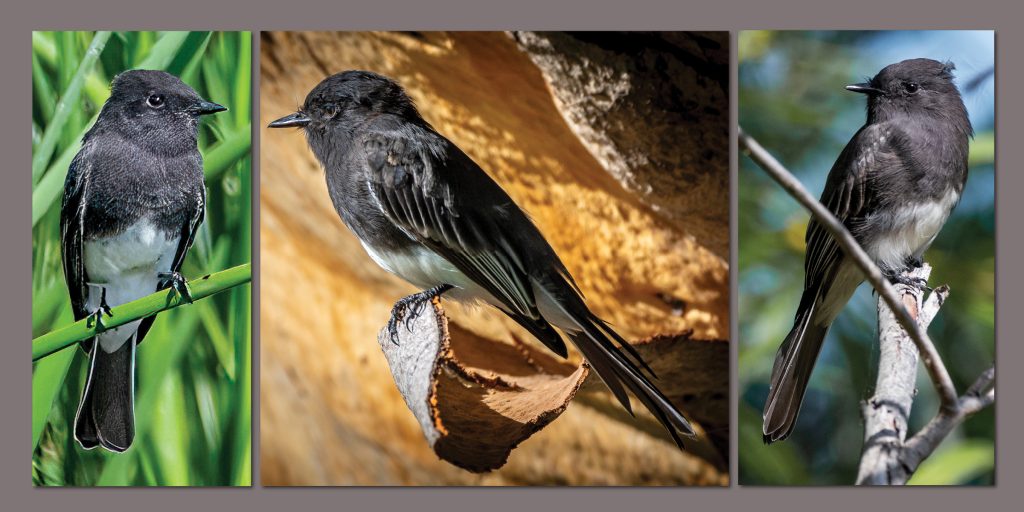
Photos by James Kendall. Essay by Betty Kanne
The Black Phoebe is a favorite resident songster in our parks, yards and nature corridors wherever a water source is present.The sharp whistled call of the Black Phoebe is a very typical sound along creeks and ponds throughout the southwest. They abundantly sing out their name, phoe-be, phoe-be!, boldly declaring their vibrant presence.
Solitary feeders, they are “wait-and-sally” flycatchers, usually waiting on low perches for an insect to come into view and then flying out, grabbing it and returning to the same perch. There, it will wait, watch, and pump its tail.
Observers will notice that it catches insects in mid-air, or may hover while picking them from foliage or sometimes from water’s surface. They feed on a wide variety of insects including beetles, grasshoppers, crickets, wild bees, wasps, flies, moths, caterpillars. Indigestible parts of insects are coughed up as pellets.
The dapper appearance and stately stance of this distinctive flycatcher make a lasting impression upon the observer. It has mostly black-appearing, dark sooty-gray upperparts and a white belly ending at the upper breast with an inverted ‘V’ surrounded by a dark sooty-colored throat area. Black Phoebes have a very large, squarish head that frequently shows a peak, like many other flycatchers. Adult males and females look alike. Juveniles have reddish-brown edges on feathers on their backs, most conspicuously on the edges of the wing coverts. Both parents actively feed their fledgling chicks and juveniles until maturity.
Black Phoebes are generally non-migratory, permanent residents in our community. The Black Phoebe is territorial, monogamous and pairing may last for up to five years. Their joyful calling, striking beauty and persistent insect suppression capabilities make them a valued year-round presence in the Urban Forest.
AUGUST BIRD OF THE MONTH:
|
Warblers are generally recognized as the tiny, flashing, colorful jewels of the forest. They are typically few in number and often artfully conceal themselves until the male decides to dramatically reveal his presence in vibrant song. Each species of warbler has a unique, memorable song that signals his arrival, his presence, and his intention. The distinctive, repeated, whistled-note song of the Yellow Warbler is often remembered with the mnemonic “sweet, sweet, sweet, I’m so sweet!”.
The Yellow Warbler’s bright, sunny coloring along with its sparkling song are a delight to the eye and music to the ear as locally breeding, as well as migrating, Yellow Warblers make their presence known in the Urban Forest.
The male Yellow Warbler is noted for its vibrant yellow plumage with fine chestnut breast streaks. Females and immatures are a much drabber yellow but the beady black eye and stout bill help to confirm the species identification.
Yellow Warblers thrive in a riparian habitat where nearby bubbling streams and waterways are edged with willows, sycamores and other deciduous trees providing abundant insects and nutritious caterpillars to feast upon as they flit nervously through the thicket offering snatched glimpses of dazzling yellow feathers.
The female builds a small round nest in the leafy tree tops for her small clutch of eggs. Unfortunately that nest is often surreptitiously targeted by the female Brown-headed Cowbird, a nest parasite, who will secretly, quickly lay her own egg in that nest to be incubated, hatched and fed unwittingly by the Yellow Warbler parents alongside their own smaller, more vulnerable chicks. The nest parasitism of the Brown-headed Cowbird, along with a dramatic loss of suitable nesting habitat has led to significant population declines of Yellow Warblers.
We value the role of the Yellow Warbler in keeping crop destroying insect and caterpillar populations in check just as we welcome their striking beauty and vibrant song in our parks and forests. Watch and listen attentively for this beguiling songster as you stroll through the towering trees of the Urban Forest.
Urban Forest Monthly Survey
August 31, 2023
31 species, 271 individuals observed
Lena Hayashi, Betty Kanne (eBirder), Dave and Sharon Telford, Jim Kendall, and Jim Currie were the surveyors. We began at 7:30 AM. It was a humid, initially overcast day in the mid-70s. The species count continues to be low this month now that breeding season is over, and most birds stop singing and molt their feathers. The year-round residents are still here, just quiet and hiding.
We did enjoy a noisy family of Hooded Orioles that come here to breed but will be migrating south soon. Also, we were all glad to see an American Kestrel as we were finishing our survey. He perched on the sign reading, “Environmentally Sensitive Area DO NOT ENTER Stay on Trail.” He is hunting and many ground-feeding birds are the reasons why!
Don’t forget to click the link to view the photos on the eBird list below to see the AMKE. HOOR photos, and many more!
Observations
-
Number observed: 9
-
Number observed: 2
-
Number observed: 6
-
Number observed: 1
-
Number observed: 45
-
Number observed: 6
-
Number observed: 31
© James Kendall Macaulay Library © James Kendall Macaulay Library © Lena Hayashi Macaulay Library -
Number observed: 1
-
Number observed: 1
-
Number observed: 2
-
Number observed: 1
© James Kendall Macaulay Library -
Number observed: 1
-
Number observed: 6
-
Number observed: 1
© James Kendall Macaulay Library -
Number observed: 2
© James Kendall Macaulay Library © Lena Hayashi Macaulay Library -
Number observed: 1
-
Number observed: 17
-
Number observed: 1
-
Number observed: 10
-
Number observed: 11
-
Number observed: 10
-
Number observed: 11
© James Kendall Macaulay Library © James Kendall Macaulay Library © James Kendall Macaulay Library -
Number observed: 2
© James Kendall Macaulay Library -
Number observed: 58
© James Kendall Macaulay Library -
Number observed: 12
-
Number observed: 3
-
Number observed: 1
-
Number observed: 6
-
Number observed: 6
© James Kendall Macaulay Library © James Kendall Macaulay Library © James Kendall Macaulay Library © James Kendall Macaulay Library © James Kendall Macaulay Library © Lena Hayashi Macaulay Library -
Number observed: 5
© James Kendall Macaulay Library -
JULY BIRD OF THE MONTH:
Common Yellowthroat
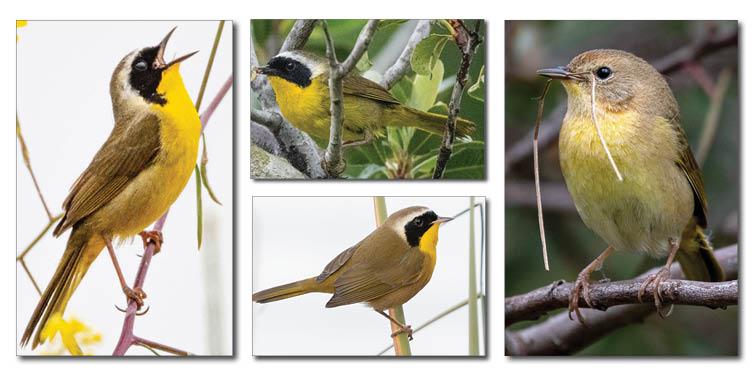 Bird of the Month essays are written by Betty Kanne with photos by James Kendall. |
The Common Yellowthroat is a year-round resident of the Urban Forest, found regularly near the low-lying creek-side pathways.This diminutive wood-warbler is just 5 inches in length and flits around secretly, staying low near dense shrubs and marshy areas. In springtime the male announces its presence vibrantly with a remarkably loud rolling wichity wichity witchity wich song, and a frequent sharp raspy jip outburst marking its nearby hidden location.
Although small and secretive, the male’s flashy bright yellow throat with a startling contrasting black face mask makes this tiny bandit pop out colorfully against its surroundings. The female’s drab olive/yellow markings and quieter habits allow her to remain protectively camouflaged within the tangled foliage.
The Common Yellowthroat feeds exclusively on insects and spiders captured in dense vegetation and sometimes deftly snatched mid-air. Their tireless efforts contribute importantly in keeping water-borne insect populations in check. It would be true to say that the Common Yellowthroat is a most uncommon beauty and one that plays an outsized role in the essential balance of our local ecosystem.
Urban Forest Monthly Survey
July 27, 2023
23 species, 253 individuals observed
The predicted high temperatures for today warranted a start an hour earlier than usual. Lena Hayashi, Betty Kanne (eBirder), Dave and Sharon Telford, Nancy Kappelmann, and dear Jim Kendall, who just returned from a month-long trip to Finland, came out to a partly foggy morning.
While forming at the HB Dog Park parking lot, we were entertained by two immature Red-tailed Hawks in the neighborhood and a gentleman pointed out a young Great-horned Owl in the eucalyptus tree in the Dog Park. Upon returning after the survey, the young hawks started squealing as a parent returned to interact with them. However, we did not observe any feeding of the young by the parent.
Once within the boundary of the Urban Forest, we were able to get a good look at an immature Cooper’s Hawk on a branch at the fence line near the culvert and another Cooper’s Hawk hunting in the field. Photos on eBird.
Most of the birds are quiet now that breeding season is over. And most of the young are independently feeding so begging sounds were few this morning.
The species counts are low but we all enjoyed the time to study bird behavior and enjoy the growth of all the vegetation this season after the bountiful winter rains. The trees have grown dramatically, and we especially enjoyed the Giant Sequoias and Redwoods Mark has planted.
Below are a few photos of the immature Red-tails and parent and the Great Horned Owl outside of the Urban Forest. Don’t forget to click the link to view the photos on the eBird list below.
Observations
-
Number observed: 7
-
Number observed: 2
-
Number observed: 20
-
Number observed: 2
-
Number observed: 1
-
Number observed: 3
© Lena Hayashi Macaulay Library © Lena Hayashi Macaulay Library © James Kendall Macaulay Library © James Kendall Macaulay Library © James Kendall Macaulay Library © James Kendall Macaulay Library -
Number observed: 25
-
Number observed: 16
-
Number observed: 15
-
Number observed: 8
-
Number observed: 2
-
Number observed: 10
© Lena Hayashi Macaulay Library © James Kendall Macaulay Library -
Number observed: 65
© James Kendall Macaulay Library -
Number observed: 57
© James Kendall Macaulay Library -
Number observed: 6
© James Kendall Macaulay Library -
Number observed: 1
-
Number observed: 1
-
Number observed: 1
-
Number observed: 3
© James Kendall Macaulay Library -
Number observed: 2
-
Number observed: 2
JUNE BIRD OF THE MONTH:
Hooded Oriole
 Bird of the Month essays are written by Betty Kanne. Photos by James Kendall. |
A highly anticipated harbinger of spring is the March/April arrival of the male Hooded Oriole, with its brilliant golden-yellow plumage and its noisy whistles and staccato chatter. The vibrant yellow hood with striking black mask has earned this slender member of the blackbird family its well deserved name.
The male is soon followed by receptive females in drabber olive-yellow plumage, providing effective camouflage as she artfully weaves her elaborate, pendulous nest carefully sewn beneath palm tree fronds, swaying 20-30 feet in the air. There, the female will incubate 3-4 eggs, followed by both parents diligently feeding the small clutch of begging hatchlings for two weeks before successfully fledging.
The Hooded Oriole feeds on a large variety insects, flower nectar, and ripe fruit. The sleek, colorful 8” bird regularly visits hummingbird feeders, acrobatically hanging upside down to drink the sweet nectar. It will also eagerly feast on a cut orange half heaped with grape jelly if provided near backyard feeders, making the Hooded Oriole a perennial neighborhood favorite that will be sorely missed when September’s shorter days remind the migrant to return to coastal Baja Mexico and Central America where it will spend its winter months.
Observations
It was a cold, overcast morning at the Urban Forest. Temperatures never rose past the mid 50’s with the slight chilling breeze. Surveyors were: Lena Hayashi, Betty Kanne (eBirder), Debra Gala, Dave and Sharon Telford, and Jim Currie. Birds were quiet and few except the House Finches, adults and juveniles, flocking together.
It was a great accomplishment to mow acres of invasive mustard from the fields. Kudos to the workers! Hoping fall planting will include some native plants, especially the California sagebrush in some of the areas to provide habitat for the endangered California Gnatcatcher.
-
Number observed: 2
-
Number observed: 12
-
Number observed: 4
-
Number observed: 8
-
Number observed: 12
© Lena Hayashi Macaulay Library -
Number observed: 4
-
Number observed: 1
-
Number observed: 1
-
Number observed: 2
-
Number observed: 1
-
Number observed: 1
-
Number observed: 5
-
Number observed: 1
-
Cassin’s/Western Kingbird
Number observed: 1 -
Number observed: 20
-
Number observed: 6
-
Number observed: 6
-
Number observed: 3
-
Number observed: 35
-
Number observed: 14
-
Number observed: 7
-
Number observed: 8
© Lena Hayashi Macaulay Library -
Number observed: 1
-
Number observed: 77
© Lena Hayashi Macaulay Library © Lena Hayashi Macaulay Library -
Number observed: 14
-
Number observed: 3
-
Number observed: 7
-
Number observed: 4
Media
-
Number observed: 2
© Lena Hayashi Macaulay Library -
Number observed: 3
-
MAY BIRD OF THE MONTH:
Song Sparrow
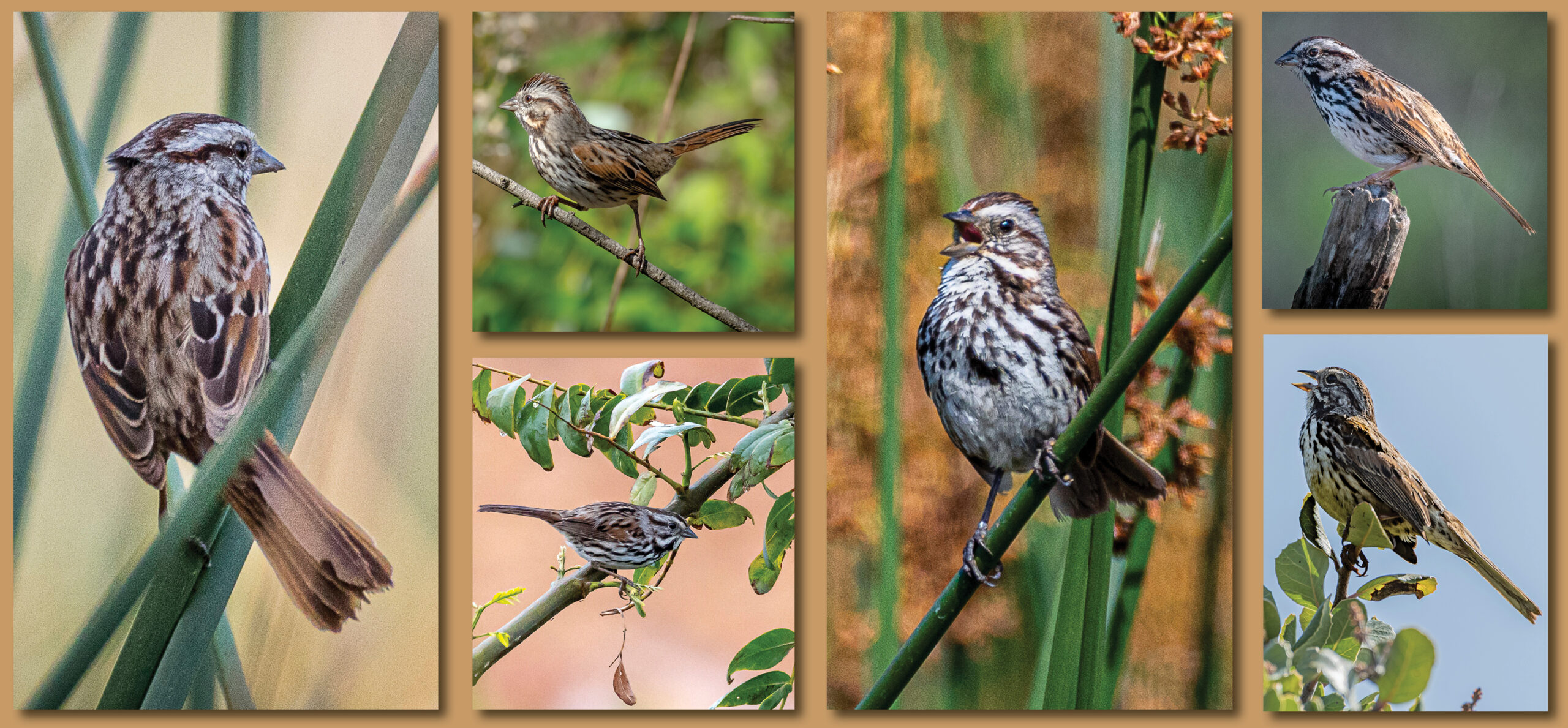 Bird of the Month essays are written by Betty Kanne with photos by James Kendall. |
The Song Sparrow is a much beloved year-round resident in the Urban Forest and adjacent verdant patches. They are readily seen as they walk or hop on the ground and flit or hop through branches, grasses, and flowering plants. Song Sparrows stay low and forage secretively, but males boldly hop up to exposed perches, including limbs of small trees, to sing. And it is in song that this diminutive bird truly stands out.
In fact, the Song Sparrow species derives its very name from its colorful repertoire of songs. The male’s vibrant song consists of a combination of repeated notes, quickly passing isolated notes, and trills. The songs are very crisp, clear and precise, making them easily distinguishable by human ears.
The male’s persistent songs, six to eight per minute at dawn in spring are associated with the maintenance of territory and the attraction of a mate. Because males and females look essentially alike, it is in their divergent behaviors that we perceive the marked differences.
The mated pair selectively searches for nest sites together. Suitable nest sites are usually hidden in grasses or weeds, sometimes placed on the ground and occasionally as high as twelve feet, quite often near a water source. Not afraid of human habitation, Song Sparrows sometimes nest close to houses, often hidden in dense flower beds and shrubs.
Song Sparrows eat many insects and other invertebrates in the summer, as well as seeds and fruits all year round. The lush and varied growth within the Urban Forest provides a bountiful habitat, ideal for the continual foraging and annual breeding needs of this most welcome sprightly songster.
Urban Forest Monthly Survey
April 27, 2023
54 species, 464 individuals observed
After being blown and rained out in February and March, April turned out to be a grand day to bird the Urban Forest. Though it was overcast and cold, seven of us enjoyed counting more species than ever before. A record number of 54 species!
Spring has sprung and we took our time to enjoy not only the birds but also the beautiful gardens and the lush vegetation and enormous growth the rains have provided throughout the forest. All the personal care and effort the volunteers put into this area do not go unnoticed! More habitat is taking over the spaces where only wild mustard used to grow. Hopefully, the fields dominated by the invasive Black Mustard can be plowed down before they set seed, to control its explosive regrowth next year. Single-species stands may look lovely at first sight but such expanses growing up to 6’ tall “produces allelopathic chemicals that prevent germination of native plants. The spread of black mustard can increase the frequency of fires in chaparral and coastal sage scrub, changing these habitats to annual grassland.” (quoted from www.cal-ipc.org under Brassica nigra).
Thanks to all my surveyor friends, especially Josh and Pema, who with their enthusiasm, acute hearing and eyesight, and knowledge of plants and animals, make surveys more productive and enjoyable for all. – Lena
APRIL BIRD OF THE MONTH:
House Wren
 Keep your eyes and ears open as you experience spring in the Urban Forest. A House Wren will most willingly serenade you if you slow down and just listen. |
A springtime stroll through the Urban Forest delights the senses with the overwhelming beauty of vibrantly colored wildflowers and sweetly scented blossoming trees and bushes. Yet, for many, it is the auditory delight of birdsong surging at dawn, continuing through to dusk that most assails our senses engendering curiosity as to which birds are singing and what messages their sweet, varied songs and calls convey.
The diminutive House Wren stands out for its sheer vocal prowess and dynamic energy. The small, inconspicuously plumaged House Wren might otherwise be difficult to notice as it flits through the dense foliage were it not for its loud, fast, jumbled musical song. The hyperactive male House Wren may perch openly and energetically sing its effervescent, bubbling songs ten times a minute to impress, attract and retain a mate throughout the spring breeding cycle. Pairs of House Wrens successfully breed throughout the park utilizing natural tree crevices and man-made nest boxes.
The House Wren is shy, but notoriously curious, spontaneously popping up in the open, holding its checkered tail straight up, cocking its head questioningly.
Keep your eyes…and ears open as you experience spring in the Urban Forest. A House Wren will most willingly serenade you if you slow down and just listen.
Observations
-
Number observed: 7
-
Number observed: 3
© Lena Hayashi Macaulay Library
-
Number observed: 5
-
Number observed: 8
-
Number observed: 15
-
Number observed: 1
-
Number observed: 5
-
Number observed: 4
-
Number observed: 1
-
Number observed: 2
-
Number observed: 1
-
Number observed: 5
-
Number observed: 2
© Lena Hayashi Macaulay Library © James Kendall Macaulay Library -
Number observed: 2
-
Number observed: 4
-
Cassin’s/Western Kingbird
Number observed: 1 -
Number observed: 1
-
Number observed: 7
-
Number observed: 15
-
Number observed: 1
-
Number observed: 12
-
Number observed: 19
-
Number observed: 17
-
Number observed: 5
-
Number observed: 26
-
Number observed: 10
-
Number observed: 12
-
Number observed: 10
-
Number observed: 2
-
Number observed: 3
© James Kendall Macaulay Library -
Number observed: 2
-
Number observed: 52
-
Number observed: 8
-
Number observed: 35
-
Number observed: 33
© James Kendall Macaulay Library © James Kendall Macaulay Library -
Number observed: 10
© James Kendall Macaulay Library © James Kendall Macaulay Library -
Number observed: 15
© James Kendall Macaulay Library -
Number observed: 4
-
Number observed: 3
-
Number observed: 4
-
Number observed: 3
-
Number observed: 2
-
Number observed: 2
-
Number observed: 15
-
Number observed: 15
© James Kendall Macaulay Library -
Number observed: 1
-
Number observed: 5
-
Number observed: 6
© James Kendall Macaulay Library -
Number observed: 6
-
Number observed: 2
-
Number observed: 5
-
Number observed: 3
-
Number observed: 10
-
Number observed: 6
-
Number observed: 11
MARCH BIRD OF THE MONTH:
Barn Swallow
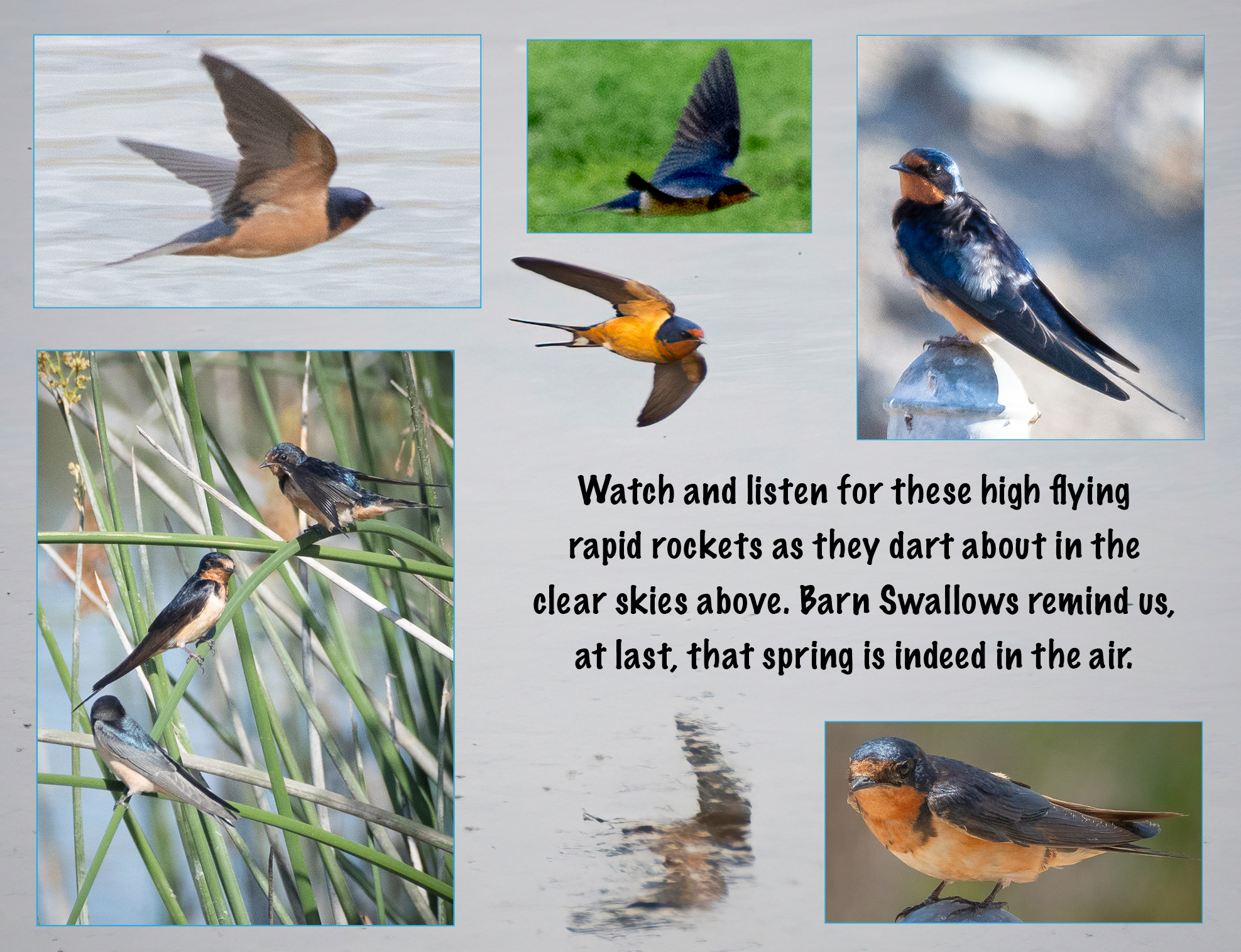 Bird of The Month essays are written by Betty Kanne with photos by James Kendall |
The March bird survey was cancelled due to rain.
Spring is quite literally in the air!
The swift flying, aerially acrobatic Barn Swallow is a beloved, time-honored symbol for the arrival of spring throughout the entire Northern Hemisphere. A long distance migrating bird, North American Barn Swallows typically over-winter in South America, reappearing late March and April to breed in the springtime and in summer months.
The high flying Barn Swallow’s most distinguishing feature is its deeply forked tail, along with steel-blue upper parts, chestnut forehead and throat with a slender cinnamon belly.
Barn Swallows are insectivores with a diet compromised mainly of flies, aphids, mosquitoes, gnats and swarming termites. A single airborne Barn Swallow will consume 60 insects per hour and up to 850 per day. They have formed a mutually beneficial relationship with people, using man-made structures for nest placement near water sources while also serving to keep insect populations in check.
The male Barn Swallow returns each Spring to the breeding area, identifying a nesting site and launching into a courtship display that involves singing and circling flight. Barn Swallows are monogamous and typically mate for life. Both parents will diligently feed their hungry nestlings and recently fledged young before they achieve independence and the ability to adroitly catch insects on the wing. They’ll need that essential expertise in order to survive the epically long migration south for the winter, followed by their welcome home return flight here next year.
FEBRUARY BIRD OF THE MONTH:
Turkey Vulture
 Photos by Urban Forest birder and photographer James Kendall |
The stately Turkey Vulture makes an impactful appearance as it slowly glides in lazy circles high above the Urban Forest on a sunny day. This massive scavenger, with a wing span of six feet, rarely flaps its wings, conserving energy by riding on thermal updrafts of air, holding its broad dark wings in a V formation, known as a dihedral, and gently rocking while surveying the broad expanse below. They rely heavily on their extraordinarily keen sense of smell to find fresh carcasses. They fly low enough to detect the gasses produced by the early process of decay in dead animals and have been known to smell carrion from over a mile away.
As a consummate scavenger, they clean up the countryside one bite of their sharply hooked bill at a time. Once one Turkey Vulture discovers a fresh carcass, others will soon join in, picking the remains clean and thereby helping to keep the ecosystem healthy and disease free. It is vital that carcasses fed upon are free of Rodenticides or other man-made contaminants so that this ecological relationship continues to flourish.
The average Turkey Vulture lives 20 years or more and congregates nightly to sleep in large communal roosts.In the early morning hours you may see Turkey Vultures sunbathing in a tree with their wings spread out. This is done to increase their body temperature after a cool night.
They will then head out on their far-ranging daily foraging flights after the sun has sufficiently warmed the ground and thermal updrafts of air begin to occur.
Urban Forest Monthly Survey for February 2023 cancelled due to rain.
__________________________
JANUARY BIRD OF THE MONTH:
Ruby-crowned Kinglet
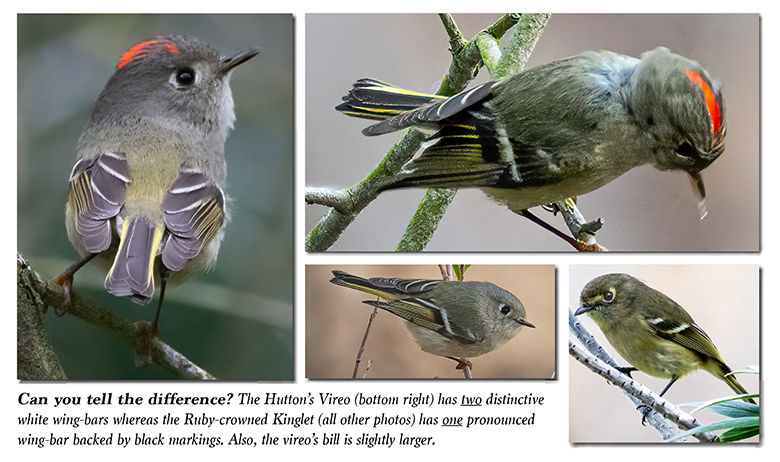 Photos compliments of James A. Kendall |
A winter walk through the core, densely tree-filled Urban Forest offers the opportunity to view the diminutive and spritely Ruby-crowned Kinglet that spends its winter months gleaning insects and tiny seeds in the mid to upper canopy of our lush abundant trees and leafy bushes.
This tiny, oval shaped dynamo measures less than 4” and its drab olive coloring offers natural concealment. It does broadcast its presence, though, by its distinctively chattering voice and nervous hyper-active behavior as it flits continually from branch to branch, flicking its wings to startle and devour insects. From this tiny bird, the startling loud ji-dit call directs observers to its obscure location.
Viewing the well-concealed “Ruby Crown” is an astonishing reward for patient observation. An attentive observer will be delighted to see the infrequent, abrupt flashing of bright red crown feathers that pop up menacingly when males display aggressively or excitedly.
Doppelgänger! A remarkably similar looking Hutton’s Vireo resides year-round in the Urban Forest. A practiced eye will note subtle but definitive differences. The vireo has two distinctive white wing-bars whereas the Ruby-crowned Kinglet has one pronounced wing-bar backed by black markings. The vireo’s bill is larger and sturdier and its slower sedate movements contrast markedly against the Ruby-crowned Kinglet’s frenzied, jittery behavior.
It often takes a second serious look, along with attentive listening, to achieve absolute certainty in winter months. It’s a worthwhile challenge that only enhances the pleasure of a brisk-air winter walk through the Urban Forest.
Urban Forest Monthly Survey
January 26, 2023
32 species, 169 individuals observed (unofficial survey)
Canada Goose (Branta canadensis) 1
Eurasian Collared-Dove (Streptopelia decaocto) 2
Anna’s Hummingbird (Calypte anna) 4
Allen’s Hummingbird (Selasphorus sasin) 12
Killdeer (Charadrius vociferus) 1
American White Pelican (Pelecanus erythrorhynchos) 7
Turkey Vulture (Cathartes aura) 1
Red-shouldered Hawk (Buteo lineatus) 1
Red-tailed Hawk (Buteo jamaicensis) 2 Ad
Downy Woodpecker (Dryobates pubescens) 1
American Kestrel (Falco sparverius) 1
Black Phoebe (Sayornis nigricans) 1
Cassin’s Kingbird (Tyrannus vociferans) 2
Hutton’s Vireo (Vireo huttoni) 1
American Crow (Corvus brachyrhynchos) 5
Bushtit (Psaltriparus minimus) 8
Swinhoe’s White-eye (Zosterops simplex) 1
Blue-gray Gnatcatcher (Polioptila caerulea) 1
House Wren (Troglodytes aedon) 4
European Starling (Sturnus vulgaris) 7
Hermit Thrush (Catharus guttatus) 6
American Robin (Turdus migratorius) 23
Cedar Waxwing (Bombycilla cedrorum) 7
House Finch (Haemorhous mexicanus) 14
Lesser Goldfinch (Spinus psaltria) 3
American Goldfinch (Spinus tristis) 7
White-crowned Sparrow (Zonotrichia leucophrys) 4
Song Sparrow (Melospiza melodia) 2
California Towhee (Melozone crissalis) 5
Western Meadowlark (Sturnella neglecta) 30
Common Yellowthroat (Geothlypis trichas) 1
Yellow-rumped Warbler (Setophaga coronata) 4
_________________________________________________________
DECEMBER BIRD OF THE MONTH:
Yellow-rumped Warbler
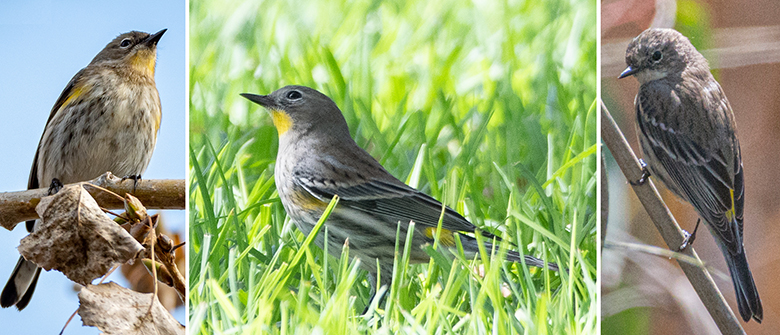 Photos by James Kendall |
The small, active Yellow-rumped Warbler is our most abundant winter warbler. It flits energetically through the tree canopy and shrubs throughout the Urban Forest from October to April when it then migrates north to coniferous forests in higher elevations to breed in spring and summer months.
True to its name, this warbler always shows a bright yellow rump-patch, earning the colloquial nickname “butter-butt” as it pulses through the trees, announcing its presence with an abrupt “CHWIT!” call.
Our local “Audubon” subspecies displays a distinctive yellow throat patch and yellow side patches in addition to its eponymous yellow-rump. Bright white markings as wing bars, under-tail spots and broken eye-rings help to confirm its identification even as winter plumage lessens the crispness and contrast of its coloration.
The Yellow-rumped Warbler enjoys a remarkably varied diet of insects, seeds and berries allowing it to thrive in very diverse habitats. This winter visitor is attracted to winter-flowering eucalyptus and bright red Toyon berries. Tall elderberry bushes offer a feast of tiny fruit and attracted insects. This diversity of diet has proven to be a veritable super-power for this migrant that can thrive in neighborhood parks, gardens and dense forests where social groups mingle contentedly. They can even be observed in mixed flocks with sparrows and finches foraging on the ground, trees and bushes. A broad flexible diet and gregarious nature have helped to make the Yellow-rumped Warbler one of North America’s most successful and abundant winter warblers.
Urban Forest Monthly Survey
January 2, 2023
41 species, 412 individuals observed
-
Number observed: 12
-
Number observed: 5
-
Number observed: 5
-
Number observed: 4
-
Number observed: 6
-
Number observed: 2
-
Number observed: 2
-
Number observed: 1
-
Number observed: 1
-
Number observed: 1
-
Number observed: 1
-
Number observed: 2
-
Number observed: 4
-
Number observed: 2
-
Number observed: 1
-
Number observed: 2
-
Number observed: 60
-
Number observed: 13
-
Number observed: 5
-
Number observed: 2
-
Number observed: 3
-
Number observed: 4
-
Number observed: 19
-
Number observed: 80
-
Number observed: 1
-
Number observed: 2
-
Number observed: 23
-
Number observed: 12
-
Number observed: 13
-
Number observed: 2
-
Number observed: 60
-
Number observed: 1
-
Number observed: 2
-
Number observed: 4
-
Number observed: 3
-
Number observed: 17
-
Number observed: 15
-
Number observed: 1
-
Number observed: 3
-
Number observed: 4
-
Number observed: 12
ADDITIONAL SPECIES SEEN BY STEVE MORRIS:
42. Lincoln’s Sparrow
__________________________________________________________
NOVEMBER BIRD OF THE MONTH:
Hummingbird
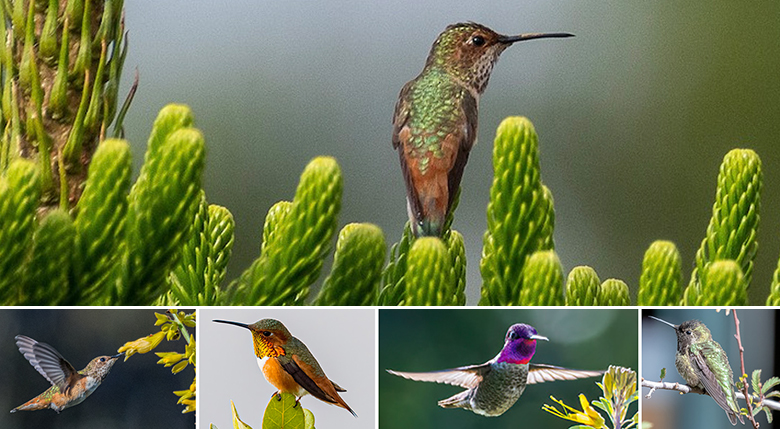 The top photo and the other two Allen’s Hummingbirds on the left, as well as the two Anna’s Hummingbirds on the right, are both plentiful year-round residents in the Urban Forest. Photos compliments of James Kendall |
Each day throughout the year, observant visitors to the Urban Forest and its surrounding gardens are treated to the fascinating spectacle of tiny dynamic aerialists that suddenly appear as hovering iridescent jewels as they dart from blossom to blossom, urgently seeking and sipping life-sustaining nectar.
Two species of hummingbirds make this park their year-round home. The Anna’s Hummingbird is recognized by its flash of shimmering magenta at the gorget/throat and forehead contrasting with its shiny green body. That flash of magenta/red and green are unmistakable field marks of the male Anna’s.
Allen’s Hummingbirds present as coppery rufous and green overall. Adult males have a coppery rufous-brown tail, eye patch, and belly that contrasts with their bronze-green back and deep reddish, golden-orange shimmering gorget. The startling jewel-like flash of color at the throat relies on capturing rays of sunlight in order to display its vibrant visual magic. Adult male of the species command this alluring attention-capturing display capacity. The drabber female is in fact the sole intended audience of his vivacious choreographed presentation that artfully combines rapid aerial feats with a vibrantly colorful light show and burst of sound.
Once successfully courted, the female constructs her ingenious tiny cup nest from resilient spider-silk, lichen and leaf matter, a stretchy thimble-like cradle to protect two coffee bean-shaped and -sized white eggs. She will diligently incubate for two weeks before hatching, then nurse the growing nestlings with nectar and insects for three weeks more before they fledge the nest and forage on their own.
Due to our mild coastal climate, Anna’s and Allen’s Hummingbirds can continuously breed year-round in our local parks and yards. Watch for this fascinating spectacle of nature as they busily thrive amidst our flowering trees, bushes and flowering plants cycling throughout the seasons. These airborne jewels act as highly efficient and key essential pollinators as they hover, sip nectar and then zip rapidly from blossom to blossom in this reciprocally beneficial cycle of life.
_________________________________________________________
Urban Forest Monthly Survey
November 24, 2022
32 species, 259 individuals observed
Thanksgiving Day and this marks the third anniversary of bird surveys at the Urban Forest!
It started as a beautiful, calm, and sunny morning with temperatures in the 60s. Betty Kanne, the spark that initiated these surveys, as usual was kind enough to record the eBird list and Jim Kendall came with his camera. Jim has captured countless wonderful photos documenting the birds of the Urban Forest since the very first survey in 2020. We were so happy to have Mark Johnston, a near-by resident of the Urban Forest and excellent birder, return for the count today. Lastly, Joshua Joun, who rushed to catch up with us, completed the group adding his infectious enthusiasm for birding on this anniversary day.
The Santa Ana winds probably limited the number of species but not until we had time to leisurely enjoy walking and appreciating the labor of love from the many volunteers who have and continue to create this magical Urban Forest.
Observations
-
Number observed: 4
-
Number observed: 3
-
Number observed: 3
-
Number observed: 4
-
Number observed: 3
-
Number observed: 2
-
Number observed: 1
-
Number observed: 1
-
Number observed: 2
-
Number observed: 6
© James Kendall Macaulay Library -
Number observed: 2
-
Number observed: 1
-
Number observed: 1
-
Number observed: 6
-
Number observed: 6
-
Number observed: 4
-
Number observed: 2
-
Number observed: 1
-
Number observed: 2
-
Number observed: 3
© James Kendall Macaulay Library © James Kendall Macaulay Library -
Number observed: 2
-
Number observed: 70
© James Kendall Macaulay Library © James Kendall Macaulay Library © James Kendall Macaulay Library -
Number observed: 2
-
Number observed: 35
-
Number observed: 5
-
Number observed: 2
© James Kendall Macaulay Library -
Number observed: 12
© James Kendall Macaulay Library -
Number observed: 2
-
Number observed: 45
© James Kendall Macaulay Library © James Kendall Macaulay Library -
Number observed: 1
-
Number observed: 3
-
Yellow-rumped Warbler
Number observed: 23
OCTOBER BIRD OF THE MONTH:
Cooper’s Hawk
 This fierce, locally common raptor is known by many different names throughout North America, including the chicken hawk, striker, and flying cross. It is a crow-sized hawk. It is often identified by its proportionally large flat head, long and banded tail feathers, and fierce hunting habits under the canopy of wooded forests where they use their remarkable speed and agility to stalk and ambush elusive prey species. Their long tails act as rudders that allow them to be extremely maneuverable in wooded areas as they careen adroitly through the forest, hunting birds on the wing. While they mainly eat smaller birds, they can also prey on small mammals, including squirrels. The Cooper’s Hawk is a resident, breeding bird that has adapted to flourish in city parks and tree-lined streets with attractively landscaped neighborhoods. Here, it can remain well-concealed in foliage before bursting forth to rapidly seize its favored, unwitting prey of dove-sized birds. Accordingly, a well-stocked backyard bird feeder can unintentionally serve to provide an avian buffet to this keenly vigilant and highly efficient bird of prey. Notice the yellow eyes of the juvenile, and red eyes of the adult Cooper’s Hawks. Photos by James Kendall |
Urban Forest Monthly Survey
October 27, 2022
34 species, 434 individuals observed
It was a beautiful day. Sunny, clear, and calm with temperatures in the mid 60’s to begin and 70 at the end! Surveyors this morning were Lena Hayashi, Betty Kanne (eBirder), Ellen Tipping, Jim Kendall, Dave and Sharon Telford, and welcomed Cheryl Searcy, a first timer at UF.
The highlight was the Western Meadowlarks in the open field as we began our survey. It was exciting to see their return as a few of them landed in the large open field and disappeared, even though they are bright yellow and black. The pattern on their bodies and reflection from the light camouflage them instantly when they land. As we watched them on the ground, we counted several more meadowlarks. But, a few minutes later, when something startled them, we counted 50 in the air, a lot more than we detected on the ground! Such is the fun of birding.
While surveying, we were able to take time to review and study the various sounds and song of the White-crowned Sparrows and listen to resident Song Sparrows practice their songs. Winter sounds of Ruby-crowned Kinglets, Blue-gray Gnatcatchers, Say’s Phoebes, and of course, Yellow-rumped Warblers filled the air.
We look forward to more winter residents returning to the Urban Forest.
-
Number observed: 25
-
Number observed: 4
-
Number observed: 4
-
Number observed: 16
© James Kendall Macaulay Library -
Number observed: 1
-
Number observed: 2
-
Number observed: 1
-
Number observed: 4
-
Number observed: 1
-
Number observed: 1
-
Number observed: 6
-
Number observed: 3
© James Kendall Macaulay Library © James Kendall Macaulay Library -
Number observed: 30
-
Number observed: 39
-
Number observed: 22
-
Number observed: 6
© James Kendall Macaulay Library -
Number observed: 3
-
Number observed: 4
-
Number observed: 4
-
Number observed: 3
-
Number observed: 4
-
Number observed: 80
© James Kendall Macaulay Library © James Kendall Macaulay Library -
Number observed: 3
© James Kendall Macaulay Library © James Kendall Macaulay Library -
Number observed: 2
-
Number observed: 30
© James Kendall Macaulay Library © James Kendall Macaulay Library -
Number observed: 10
-
Number observed: 5
-
Number observed: 2
-
Number observed: 50
-
Number observed: 30
© James Kendall Macaulay Library © James Kendall Macaulay Library © James Kendall Macaulay Library -
Number observed: 4
SEPTEMBER BIRD OF THE MONTH:
Hermit Thrush
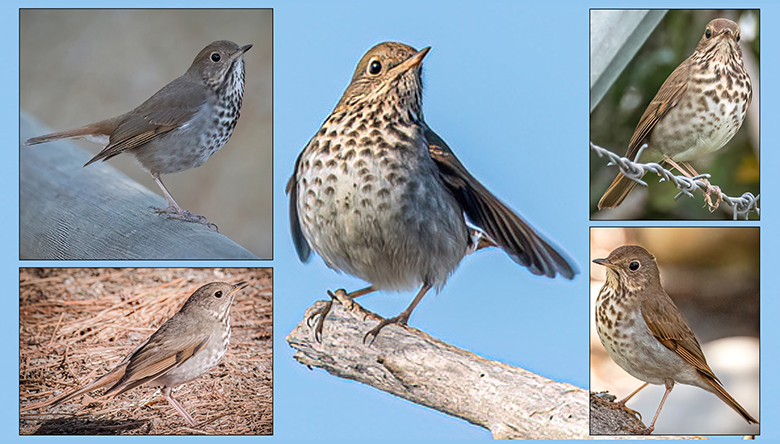 Fall birding means the welcome return of the secretive Hermit Thrush that revels in its own company diligently rummaging through the leaf litter and forest under-story in search of spiders, ants, earthworms, and insects of all varieties. A favorite winter food includes the red berries fallen from our abundant native Toyon bushes and other fruit bearing winter shrubs. Although favoring the dark, shadowy areas under bushes and trees, listen attentively for its loud, abrupt “TCHUP!” call, revealing its presence only a few feet away! Once there, you’ll behold this ground-foraging small brown bird with a thin dark bill standing out as it nervously flicks its wings and contrasting reddish-brown tail that lifts up-and-down confirming its identification even before revealing its heavily spotted breast. A beady black eye, narrowly ringed in white contributes to a startlingly distinctive appearance. Enjoy this diligent hermit as it over-winters with us and before the springtime draws it to northern, higher elevations for spring/summer breeding. |
September 22, 2022, & BIRD-A-THON Observations
41 species observed, 315 individuals
Team Lena’s Legion kicked off the first Urban Forest Bird-A-Thon this morning. It was a beautiful day. Sunny, clear, and calm with temperatures in the mid 70’s and NOT HUMID! Lena’s army of wonderfully talented, fun-loving, and talkative birders included Betty Kanne, Ellen Tipping, Jim Kendall, Jim Currie, Brenda Sabin, Debra Gala, Claire Grozinger, Pema Zonglo, and Josh Joun. Everyone had a great time scanning the sky, trees, and shrubs calling out birds and directing others to see them. Kudos to Ellen who always had a kind smile and nod as she skillfully and accurately recorded the species and numbers on eBird as 9 of us called out sightings.
41 species were seen, thanks to Josh and Pema who saw a Say’s Phoebe on their way out of the Urban Forest, and a total of 312 birds were counted. Today we welcomed back some of our winter residents: Say’s Phoebe, Blue-gray Gnatcatcher, Hermit Thrush, Townsend’s Warbler, Savannah Sparrow, and White-crowned Sparrows.
Our Sept. 22-25 BIRD-A-THON goal has been to raise money for the Urban Forest to provide more native habitats, especially with California Sagebrush, Artemisia californica, to entice the endangered California Gnatcatcher to reside in the Urban Forest.
-
Number observed: 34
-
Number observed: 20
-
Number observed: 10
-
Number observed: 10
© James Kendall Macaulay Library -
Number observed: 1
-
Number observed: 1
-
Number observed: 1
-
Number observed: 2
-
Number observed: 1
© Lena Hayashi Macaulay Library © James Kendall Macaulay Library -
Number observed: 1
-
Number observed: 1
-
Number observed: 2
-
Number observed: 1
© James Kendall Macaulay Librar -
Number observed: 3
-
Number observed: 6
© James Kendall Macaulay Library © James Kendall Macaulay Library -
Number observed: 1
© James Kendall Macaulay Library -
Number observed: 28
-
Number observed: 13
© James Kendall Macaulay Library -
Number observed: 10
-
Number observed: 3
-
Number observed: 6
© James Kendall Macaulay Library -
Number observed: 3
© James Kendall Macaulay Library -
Number observed: 1
-
Number observed: 3
-
Number observed: 2
© James Kendall Macaulay Library -
Number observed: 97
© James Kendall Macaulay Library -
Number observed: 13
© James Kendall Macaulay Library © James Kendall Macaulay Library -
Number observed: 5
-
Number observed: 1
-
Number observed: 1
-
Number observed: 2
-
Number observed: 7
-
Number observed: 8
© James Kendall Macaulay Library © James Kendall Macaulay Library -
Number observed: 2
-
Number observed: 3
© James Kendall Macaulay Library -
Number observed: 6
-
Number observed: 1
-
Number observed: 1
-
Number observed: 2
-
Number observed: 2
© James Kendall Macaulay Library
AUGUST BIRD OF THE MONTH:
California Towhee
Did you hear that? …. Wait! I hear it again. That abrupt, sharp metallic TINK!
That’s the “calling”-card announcement of the California Towhee!
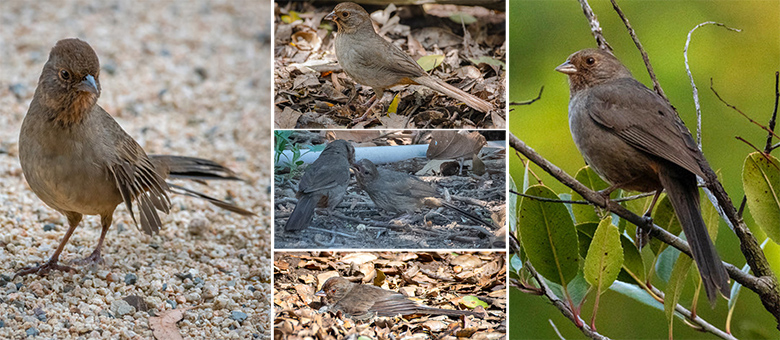 Peer down into the leaf-litter and you’ll see this largish, 9”, dusty-brown, long-tailed bird eagerly shuffling through the ground cover looking for grubs, or briefly perched in nearby bushes. Its drab gray/brown appearance is nicely offset by a rusty/orange patch under-tail and surrounding a thick darkish bill. This successful breeder in our local tree-filled parks will likely have its similar looking mate quite close by, listening intently for that identifying TINK! call and ready to respond. Photos by James Kendall |
On a sunny, humid morning with temperatures in the 70s, Lena Hayashi, Betty Kanne (eBirder), Claire Grozinger, Jim Kendall, Dave and Sharon Telford, and Josh Joun counted all the birds we could hear and see for two hours.
Early on and throughout the morning, we watched flocks of Red-necked Phalaropes fly across the Urban Forest from Lake Huntington to Bolsa Chica. The birds were mostly quiet except for the House Finches, Swinhoe’s White-eyes, and Lesser Goldfinches. There was a snippet of a song from a House Wren but the other birds only called occasionally.
While under the cool canopy of the Urban Forest, we also discussed our Team name for the BIRD-A-THON weekend coming up for next month to herald the beginning of fall migration. We are hoping to come up with a fun and catchy name. Our survey group will kick off the event on Thursday, September 22, at 8:00 a.m. Our survey will be one week earlier than our usual last Thursday of the month. Our goal is to raise money for the Urban Forest and to provide more native habitats, especially with California Sagebrush, Artemisia Californica, to entice the endangered California Gnatcatcher to reside in the Urban Forest. If you can’t join us, please consider a team of your own. You can bird anytime and any day from Thursday, September 22 to Sunday, September 25, alone, with children, your dog, friends, or family. Make it a fun event. Check out the webpage https://hbtrees.org/hb-urban-forest-bird-a-thon/ for more information. We would appreciate a donation of any amount and all donations are tax deductible. TAX ID: EIN 33-0815267
Thanks so much! Enjoy the list and photos below. – Lena Hayashi
August 25, 2022 Observations
34 species , 335 individuals observed
-
Number observed: 2
-
Number observed: 1
-
Number observed: 2
-
Number observed: 3
-
Number observed: 7
© James Kendall Macaulay Library -
Number observed: 23
-
Number observed: 120
-
Number observed: 1
-
Number observed: 1
-
Number observed: 1
-
Number observed: 1
© Lena Hayashi Macaulay Library -
Number observed: 1
-
woodpecker sp.
Number observed: 1 -
Number observed: 2
© James Kendall Macaulay Library © James Kendall Macaulay Library -
Number observed: 2
© James Kendall Macaulay Library -
Number observed: 6
-
Number observed: 1
-
Number observed: 11
-
Number observed: 1
-
Number observed: 1
-
Number observed: 4
-
Number observed: 25
© James Kendall Macaulay Library -
Number observed: 5
-
Number observed: 1
-
Number observed: 2
-
Number observed: 66
© James Kendall Macaulay Library -
Number observed: 25
© James Kendall Macaulay Library -
Number observed: 1
-
Number observed: 5
© James Kendall Macaulay Library -
Number observed: 6
© James Kendall Macaulay Library -
Number observed: 1
-
Number observed: 3
-
Number observed: 2
-
_________________________________________________________________
JULY BIRD OF THE MONTH:
Bushtit!
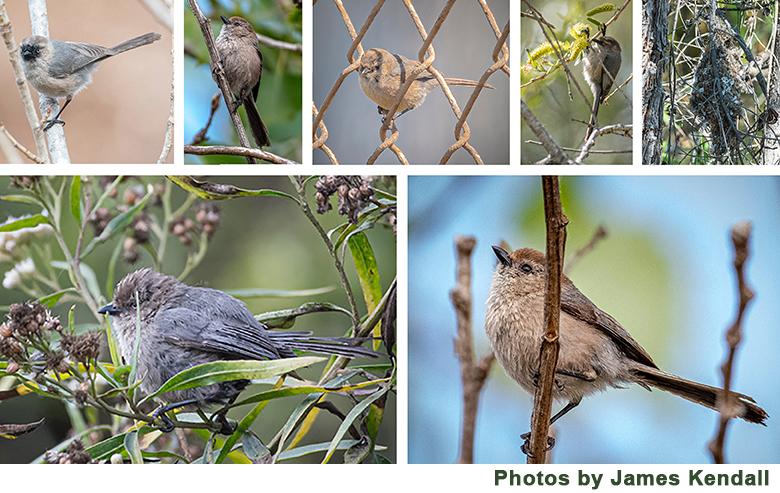 Bottom left is the light-eyed female, and bottom right is the dark-eyed male. At top right, notice the unusual hanging nest that these inconspicuous yet common birds weave. |
Bushtits are tiny, long-tailed gray birds that travel in large busy flocks, relentlessly rocketing from one leafy bush or tree to the next, all while keeping up a contestant rapid twittering in order to keep the gang in active motion. These dynamic acrobats often hang upside down as they rapidly glean insects from leafy shrubbery. A careful observation of these frenetically moving dynamos, will disclose that the males have dark eyes whereas the female has a pale yellowish eye providing stark contrast to its tiny gray body.
Bushtits are common year-round inhabitants of urban parks and neighborhoods throughout the West and Southwest. Watch and listen for these diminutive dynamos as they sweep through your own backyard!
-
Number observed: 10
-
Number observed: 28
-
Number observed: 2
-
Number observed: 5
-
Number observed: 5
-
Number observed: 20
© James Kendall Macaulay Library © James Kendall Macaulay Library © Joshua Joun Macaulay Library -
Number observed: 1
-
Number observed: 1
-
Number observed: 2
© Lena Hayashi Macaulay Library © Lena Hayashi Macaulay Library © James Kendall Macaulay Library © James Kendall Macaulay Library -
Number observed: 2
-
Empidonax sp.
Number observed: 1 -
Number observed: 6
-
Number observed: 1
© Lena Hayashi Macaulay Library © James Kendall Macaulay Library © Joshua Joun Macaulay Library -
Number observed: 2
© Joshua Joun Macaulay Library -
Number observed: 16
-
Number observed: 2
-
Number observed: 1
-
Number observed: 44
© James Kendall Macaulay Library © James Kendall Macaulay Library -
Number observed: 25
-
Number observed: 6
© James Kendall Macaulay Library -
Number observed: 2
-
Number observed: 1
© James Kendall Macaulay Library © James Kendall Macaulay Librar -
Number observed: 100
-
Number observed: 2
-
Number observed: 3
-
Number observed: 2
-
Number observed: 2
© James Kendall Macaulay Library -
Number observed: 5
© James Kendall Macaulay Library -
Common Yellowthroat
_________________________________________________________________
JUNE BIRD OF THE MONTH:
Western Bluebird
HB Tree Society names the Western Bluebird
as official mascot & spokesbird of the Urban Forest!
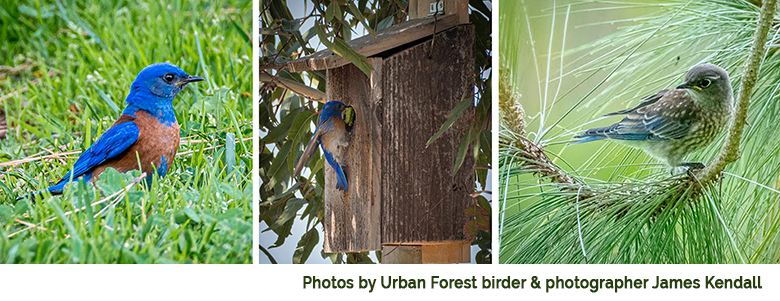 |
The Western Bluebird was selected because it’s a perfect representative for the Urban Forest. Both entities manifest hope, resilience and renewal in the face of myriad challenges to our natural environment.
The Western Bluebird came close to entirely disappearing in Orange County in the last century due to destruction of its needed forested environment that was being rapidly urbanized without essential mitigation. An association of concerned birders arose 30 years ago to place customized nest boxes in key parks across the county providing a lifeline for a beloved species on the edge of disappearance in our urban areas. The Southern California Bluebird Club continues this focused mission throughout the southland to great success (see also: socalbluebirds.org).
Likewise, the Urban Forest rose from tiny seedlings planted a mere 20 years ago into a maturing, towering forest in a lush, vibrant environment providing ideal nesting opportunities for the vulnerable Western Bluebird. The Western Bluebird thrives in this forested habitat offering natural crevices for nesting as well as abundant food sources. Urban Forest volunteers supplement tree crevices with customized nest boxes perfectly designed for Western Bluebirds’ breeding success.
Read more about the Western Bluebird and its new spokesbird status by clicking here.
June 30, 2022, Observations
33 species, 218 individuals observed
It was a beautiful sunny, clear, and calm morning, rising to 72 or so degrees. Surveyors were only four – Lena Hayashi, Betty Kanne (eBirder), Sharon, and Dave Telford. Summer months are typically slow and quiet as breeding season winds down and fledglings depend less on their parents to feed them.
One Spotted Towhee continued to sing all morning in and around the corralled area as did several House Wrens. It was interesting to watch how family groups of Orange-crowned Warblers, Hutton’s Vireos, Bushtits, Swinhoe’s White-eyes, and House Finches kept in close contact with each other. We watched adults trying to teach their young to feed themselves and what looked like siblings just having fun chasing each other. An experience to remember was watching the antics of four Hutton’s Vireos dart about the branches, seemingly chasing each other, almost climbing onto each other, and settling still on the ground to bask in the sun or preen.
Urban Forest volunteers Phil and Robyn came by with their dog and told us which two House Wren and two Western Bluebird boxes were still active. We dutifully checked them out and were rewarded with activity in or around the boxes. Without the boxes the volunteers put up, there would not be the success rate of cavity nesting birds in the Urban Forest. We thank and appreciate them.
-
-
Number observed: 1
-
Number observed: 22
-
Number observed: 1
-
Number observed: 3
-
Number observed: 4
-
Number observed: 11
-
Number observed: 1
-
Number observed: 4
-
Number observed: 2
-
Number observed: 1
-
Number observed: 1
-
Number observed: 1
-
Number observed: 1
-
Number observed: 2
-
Number observed: 2
-
Number observed: 4
-
Number observed: 12
-
Number observed: 8
-
Number observed: 1
-
Number observed: 31
-
Number observed: 9
-
Number observed: 7
-
Number observed: 5
-
Number observed: 58
-
Number observed: 7
-
Number observed: 2
-
Number observed: 4
-
Number observed: 1
-
Number observed: 2
-
Number observed: 1
-
Number observed: 4
-
MAY BIRD OF THE MONTH:
Goldfinch!
(There’s Gold in them there trees!)
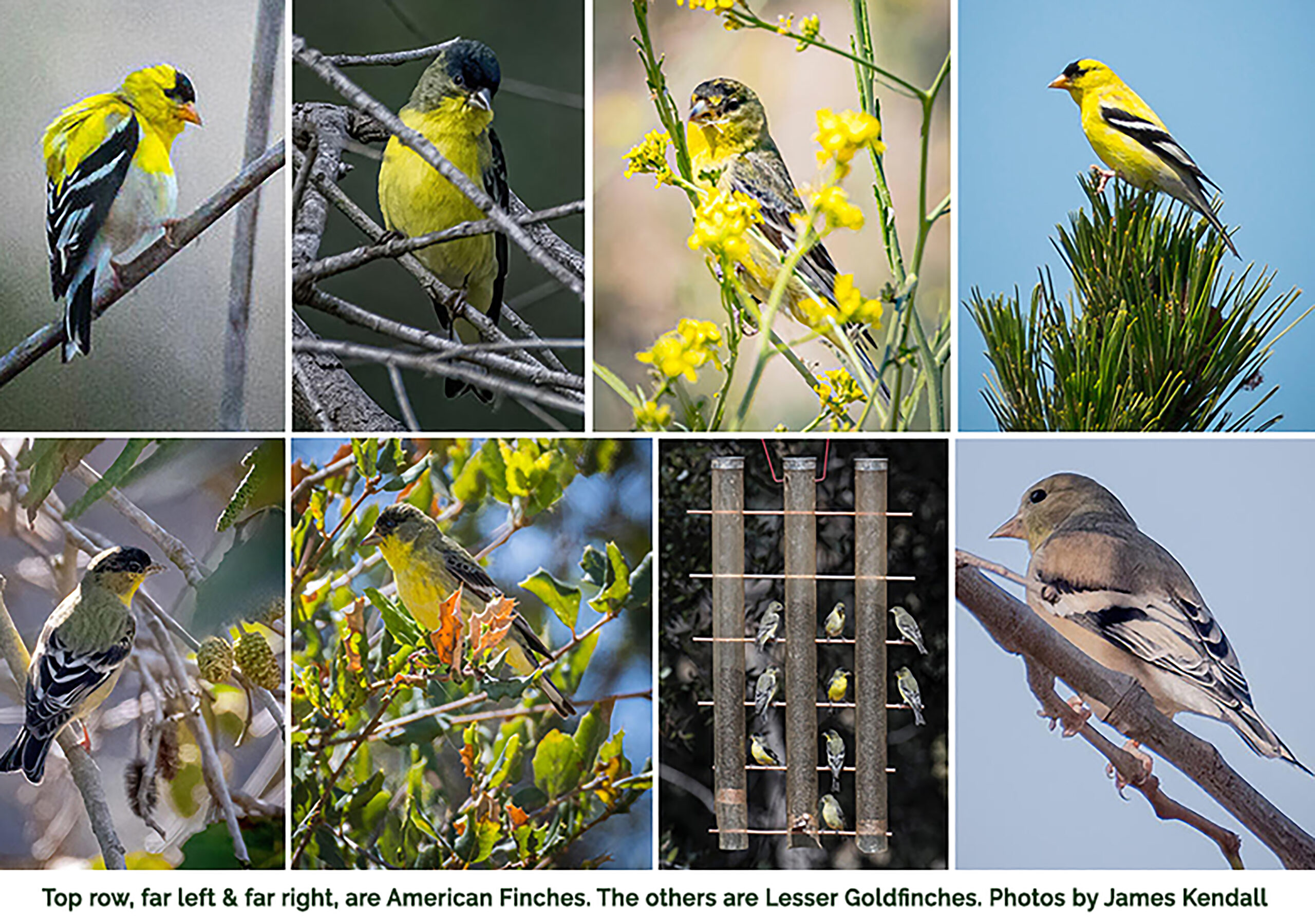 Look-up and be astounded by the beauty of these dynamic songsters as they rapidly flit among the trees, often in the upper canopy and quite often in mixed groups. Active and gregarious they flourish in the company of red-tinged, brown striped House Finches with which they share the characteristic, cone-shaped FINCH bill, so perfectly adapted to crack and eat seeds of many sizes. If you have a back-yard bird feeder, you’ll easily recognize them as familiar friends with a penchant for sunflower and shiny black Nyjer seeds. Springtime brings out the best in these flashy yellow and black acrobats. Male goldfinch transform from a duller winter aspect into their flashy yellow breeding plumage. Females brighten up as well, but keep a toned down look to conceal themselves as they dutifully sit on nests and feed chicks. A male American Goldfinch in breeding plumage is a real showstopper. His bright yellow body, back and face are nicely set off by a spiffy black cap and wings. The male Lesser Goldfinch shows off a bright yellow body but with a dark back and full size black hat. His shiny black wings show a bigger splash of white by way of sharp contrast. Winter, non-breeding males and females, on the other hand, don’t immediately draw your attention. They’re more of a smudgy brown and mustard color, with striped black and white wings. So enjoy the dazzling sunflower yellow of these social dynamos as they dash from tree to bush and back again all spring and summer. |
May 26, 2022, Observations
33 species, 232 individuals observed
It was a beautiful, clear, and calm morning with the temperature in the 60’s. The sun came out by the time we reached the top of the hill. Surveyors were Lena Hayashi, Dave and Sharon Telford, Jim Kendall, Rick Shearer, and Betty Kanne, who kindly did the eBird list.
Spring is magical! The plants and trees seem twice as large and beautiful as they were last month! The overwhelming songs for the morning were from the House Wrens and their bubbling rapid and musical trills and rattles, could be seen and heard everywhere. We had fun watching a juvenile perched on a cut log and chirping with its yellowish gape, as it waited for its parent to return with insects.
Other vocal birds were the Song Sparrow, Spotted Towhee, Lesser Goldfinches, Swinhole’s White-eyes, and House Finches. Hummingbirds were also active and enjoying all the nectar available from the bounty and variety of blooming flowers.
-
Number observed: 8
-
Number observed: 2
-
Number observed: 2
-
Number observed: 4
-
Number observed: 4
-
Number observed: 20
-
Number observed: 4
-
Number observed: 1
-
Number observed: 1
© James Kendall Macaulay Library -
Number observed: 1
-
Number observed: 1
© Lena Hayashi Macaulay Library © James Kendall Macaulay Library -
Number observed: 1
-
Number observed: 3
© James Kendall Macaulay Library -
Number observed: 5
-
Number observed: 2
-
Number observed: 2
© James Kendall Macaulay Library © James Kendall Macaulay Librar -
Number observed: 1
-
Number observed: 5
-
Number observed: 4
-
Number observed: 20
-
Number observed: 6
-
Number observed: 22
© Lena Hayashi Macaulay Library © James Kendall Macaulay Library © James Kendall Macaulay Library -
Number observed: 5
-
Number observed: 1
-
Number observed: 60
-
Number observed: 20
© Lena Hayashi Macaulay Library © James Kendall Macaulay Library -
Number observed: 1
-
Number observed: 13
-
Number observed: 6
© James Kendall Macaulay Library -
Number observed: 2
-
Number observed: 2
-
Number observed: 2
-
APRIL BIRD OF THE MONTH:
Orange-crowned Warbler
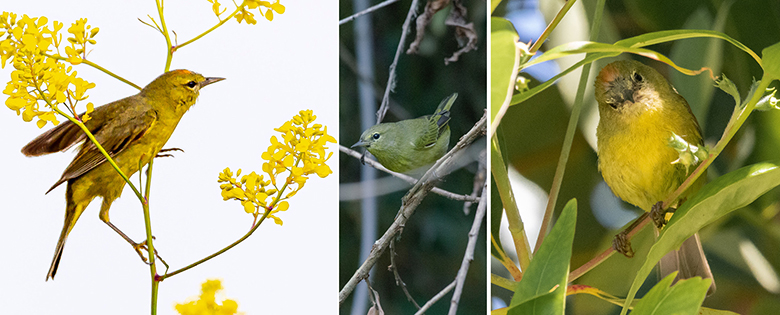 Orange-crowned Warblers are small, active song birds characterized by their rapid flitting movement through foliage and their memorable songs in springtime. The sprightly, diminutive Orange-crowned Warbler is a subdued yellow with the added surprise of orange feathers occasionally flashed on its crown when surprised or agitated. While many more strikingly colored warblers briefly migrate through Orange County on their way to northern spring breeding grounds or when returning south for warmer overwintering destinations, many Orange-crowned Warblers are local breeders, building their nests here to raise their young in our own tree-filled parks and backyards. Listen for the distinctive high-pitched staccato trill of the male this spring as he attracts a potential mate. – Photos by James Kendall |
April 28, 2022, Observations
33 species, 189 individuals observed
It was a cool, drizzly morning with the temperature in the 60’s. Our group was small this morning with Lena Hayashi, Betty Kanne (who was kind enough to eBird), Ellen Tipping, Jim Kendall, and Rick Shearer.
We were expecting a nice spring count of birds but the cold, wet weather, kept the variety and numbers quiet or away from the Urban Forest. Many singing House Wrens and displaying Hummingbirds were seen and counted as they were last month. A vocal Spotted Towhee, probably the same one that confused us last month, repeated a down slurred note periodically in between his “pweee” song. Last month he repeated a “whit-like” call, as a flycatcher would do. This one bird has fooled us two months in a row. Neither of the two sounds were found in any recorded sounds we had for Spotted Towhees. A good lesson in the field.
We marveled at the transformation of the creek area where the crossing bridge is planned. The plants and artistic placements of rocks, following the row of Sycamore trees, will become a favored path to stroll through in the future. Thanks to all the dedicated and hard-working volunteers. You are all very much appreciated. We also noticed additional bird boxes and hope for cavity nesters, other than House Wrens, to use them this spring!
1. Canada Goose
Number observed: 6
2. Mallard
Number observed: 5
3. Rock Pigeon (Feral Pigeon)
Number observed: 1
4. Mourning Dove
Number observed: 4
5. Anna’s Hummingbird
Number observed: 3
6. Allen’s Hummingbird
Number observed: 17
7. Killdeer
Number observed: 2
8. Double-crested Cormorant
Number observed: 1
9. Great Egret
Number observed: 1
10. Turkey Vulture
Number observed: 2
11. Black Phoebe
Number observed: 3
12. Say’s Phoebe
Number observed: 1
13. Cassin’s Kingbird
Number observed: 4
14. American Crow
Number observed: 17
15. Common Raven
Number observed: 2
16. Northern Rough-winged Swallow
Number observed: 3
17. Barn Swallow
Number observed: 9

© Lena Hayashi Macaulay Library
18. Bushtit
Number observed: 7
19. House Wren
Number observed: 9
20. Northern Mockingbird
Number observed: 1
21. Western Bluebird
Number observed: 5
22. American Robin
Number observed: 1
23. Scaly-breasted Munia
Number observed: 4
© Lena Hayashi Macaulay Library
24. House Finch
Number observed: 26
25. Lesser Goldfinch
Number observed: 13
26. American Goldfinch
Number observed: 4
27. Song Sparrow
Number observed: 5
28. California Towhee
Number observed: 9

© Lena Hayashi Macaulay Library
29. Hooded Oriole
Number observed: 2
30. Bullock’s Oriole
Number observed: 1
31. Orange-crowned Warbler
Number observed: 5
32. Common Yellowthroat
Number observed: 2
33. Western Tanager
Number observed: 3
_________________________________________________________________
MARCH BIRD OF THE MONTH:
American Kestrel, Falcon extraordinaire
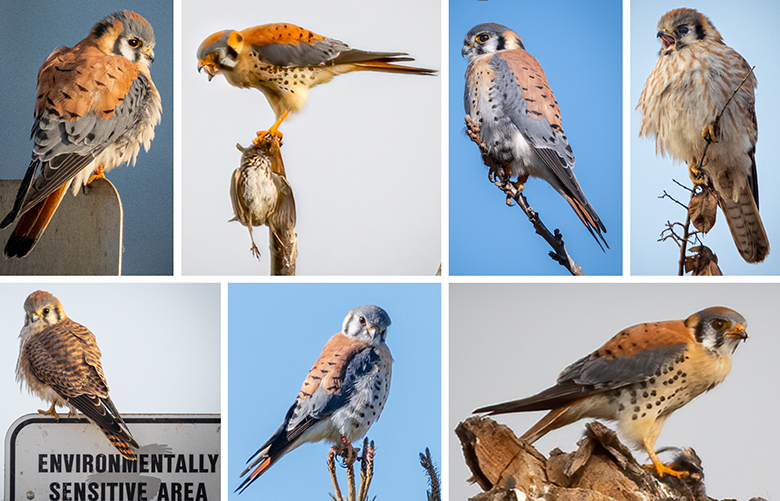 The American Kestrel is our smallest, most abundant, and most vibrantly colorful Falcon. You‘ll notice our pair of year-round resident Kestrels perched on posts in the hilltop preserved Raptor Foraging Area, surveying the field for grasshoppers, lizards, and small rodents comprising their customary prey. The more colorful male has a solid rusty back & tail with a wide black tip and contrasting blue-gray wings. Both male and female of these fiercely striking Birds of Prey sport two distinctive dark vertical face stripes. Watch for their dramatic aerial show of slow hovering mid-air facing into the wind, flapping and adjusting their long tails to stay in place before rapidly diving to seize unwitting prey in their powerful talons. – Photos by James Kendall |
March 31, 2022, Observations
37 species, 315 individuals observed
It was a cool, calm, and overcast day with the temperature in the 60’s. Our group was small this morning with Lena Hayashi, Betty Kanne (who was kind enough to eBird), Ellen Tipping, Jim Stacy, Nancy Kappelmann, and Rick Shearer.
The House Wrens were numerous and singing up a storm with one seen carrying nesting material. A vocal Spotted Towhee repeated one note of his trill, followed by extended seconds of silence. We thought we were hearing “whit-like” calls, as a flycatcher would do. Finally, the bird popped up and we all watched the Spotted Towhee make the repeated single note vocalizations. A good lesson in the field.The hummingbirds were abundant and displaying throughout the beautiful blooming gardens of the Urban Forest. Brewers Blackbirds are now regulars in the horse stables along with the Rock Pigeons.
During our three-hour survey, we all marveled at the artistic placements of rocks, benches, tree stumps, and wood carvings surrounded by colorful, blooming plants that provide so many resting and viewing areas throughout the Urban Forest. Our compliments to all the dedicated and hard-working volunteers. You are all very much appreciated. We also noticed additional bird boxes and hope for cavity nesters to use them this spring! – Lena Hayash
-
Number observed: 18
-
Number observed: 12
-
Number observed: 6
-
Number observed: 2
-
Number observed: 20
-
Number observed: 1
-
Number observed: 1
-
Number observed: 1
-
Number observed: 2
-
Number observed: 2
© Lena Hayashi Macaulay Library
-
Number observed: 1
-
Number observed: 4
-
Number observed: 1
-
Number observed: 9
-
Number observed: 3
-
Number observed: 8
-
Number observed: 2
-
Number observed: 2
-
Number observed: 13
-
Number observed: 10
© Lena Hayashi Macaulay Library -
Number observed: 1
-
Number observed: 1
-
Number observed: 1
-
Number observed: 2
-
Number observed: 62
-
Number observed: 14
-
Number observed: 1
-
Number observed: 40
-
Number observed: 10
-
Number observed: 10
-
Number observed: 2
© Lena Hayashi Macaulay Library -
Number observed: 14
-
© Lena Hayashi Macaulay Library -
Number observed: 1
-
Number observed: 2
-
Number observed: 1
-
_________________________________________________________________
FEBRUARY BIRD OF THE MONTH:
Spotted Towhee, Year-round resident
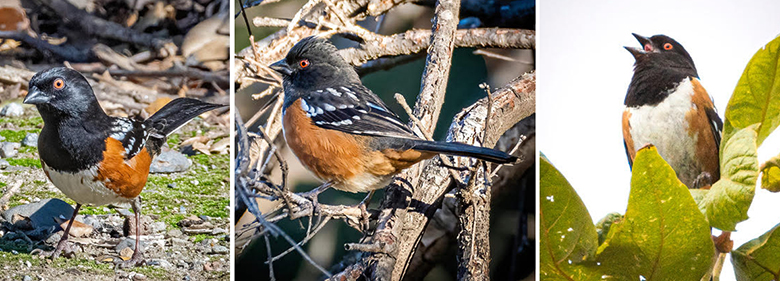
This flashy year-round resident presents itself frequently at the ground level performing its “double-scratch” foraging technique as it hops quickly forward and backward searching for seeds and insects in the leaf litter. I’m most attracted by its large size, suddenly darting out of ground cover ahead of you on a footpath for an instant before diving back into the brush, momentarily flashing black, white and chestnut color…and yes, if you’re lucky, a bright red eye. Springtime singing males may perch openly atop shrubs singing its striking whistled, then buzzy song. Look, listen and be astonished. – Photos by James Kendall
February 24, 2022, Observations
39 species, 283 individuals observed
It was very cold, but the morning was beautiful, clear, calm, and sunny, with snow-capped mountains in the distance. Temperatures ranged from 45 degrees to low 60s. Surveyors were Lena Hayashi, Betty Kanne (eBird), Dave and Sharon Telford, Jim Kendall, Ellen Tipping, Barbara Wasbin and Laura K.
Laura is one of the many hard-working volunteers at the Urban Forest. She, Phil, and Robin have designed, built, and placed nesting boxes throughout the Urban Forest. Last year, Western Bluebirds and House Wrens took advantage of them and Laura is looking forward to attracting additional species in the coming years. It was a pleasure to have her join us and hear about all the things going on at the Urban Forest and to also have her experience how we go about counting birds here each month.
We spotted a Golden-crowned Sparrow among about 30 White-crowns and two Fox Sparrows in the dense understory of a bush. What a pleasure it is to be among fellow birders who love to spend the time to get good looks at birds and study their field marks and behavior. It makes learning so enjoyable and easy.
Enjoy the list below!
-
Number observed: 4
-
Number observed: 5
-
Number observed: 7
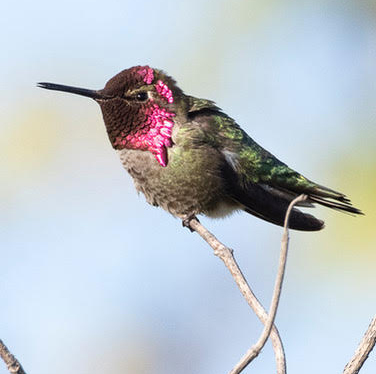
Anna’s Hummingbird © James Kendall Macaulay Library
-
Number observed: 11
-
Rufous/Allen’s Hummingbird
Number observed: 2 -
Number observed: 1
-
gull sp.
Number observed: 8 -
Number observed: 6
-
Number observed: 3

Red-tailed Hawk© James Kendall Macaulay Library
-
Number observed: 1
-
Number observed: 3
-
Number observed: 4
-
Number observed: 2
-
Number observed: 12
-
Number observed: 3
-
Number observed: 25
-
Number observed: 3
-
Number observed: 3
-
Number observed: 2
-
Number observed: 4
-
Number observed: 4
-
Number observed: 6
-
Number observed: 1
-
Number observed: 1
-
Number observed: 20
-
Number observed: 10
-
Number observed: 2
-
Number observed: 41
-
Number observed: 1
© Lena Hayashi Macaulay Library © Lena Hayashi Macaulay Library -
Number observed: 10
-
Number observed: 4
-
Number observed: 2
-
Number observed: 14
-
Number observed: 33
-
Number observed: 4
-
Number observed: 3
-
Number observed: 5
-
-
Number observed: 1
-
Number observed: 6
-
Number observed: 6
-
Number observed: 1
© James Kendall Macaulay Library -
Number observed: 2
American Kestrel photos by © James Kendall Macaulay Library -
Number observed: 1
-
Number observed: 7
© James Kendall Macaulay Library -
Number observed: 1
-
Number observed: 1
-
Number observed: 45
-
Number observed: 16
-
Number observed: 3
© James Kendall Macaulay Library -
Number observed: 1
-
Number observed: 4
-
Number observed: 1
-
Number observed: 5
-
Number observed: 50
© James Kendall Macaulay Library -
Number observed: 23
-
Number observed: 2
-
Number observed: 10
© James Kendall Macaulay Library -
Number observed: 51
White-crowned Sparrow, photos © James Kendall Macaulay Library -
Number observed: 1
© James Kendall Macaulay Library -
Number observed: 8
© James Kendall Macaulay Library -
Number observed: 3
© James Kendall Macaulay Library -
Number observed: 1
-
Number observed: 6
-
Number observed: 2
-
Number observed: 2
-
Number observed: 14
___________________________________________________________________
October 2021 Observations
32 species observed, 446 individuals

 © James Kendall Macaulay Library © James Kendall Macaulay Library |
 © James Kendall Macaulay Library © James Kendall Macaulay Library |

American Kestrel, © Lena Hayashi Macaulay Library |
 © James Kendall Macaulay Library © James Kendall Macaulay Library |
 © James Kendall Macaulay Library |
 © James Kendall Macaulay Library © James Kendall Macaulay Library |




Number observed: 3
  © James Kendall Macaulay Library |

 © James Kendall Macaulay Library © James Kendall Macaulay Library |
 © James Kendall Macaulay Library © James Kendall Macaulay Library |

Details
Horse stable area

___________________________________________________________________
September 23, 2021 Survey Results
This survey marks the first anniversary of the “official” Urban Park Bird Survey! What a wonderfully pleasant day with temperatures in the high 60s to low 70s, and clear skies with a slight breeze. Surveyors Lena Hayashi, Jim Kendall, Jim Currie, Brenda Sabin, Dave and Sharon Telford, Claire Grozinger, Betty Kanne, and Kelly Coles went as one group, spending the first part of the morning looking for migrants in the corralled area of the Urban Forest. We met Roger Schoedl who directed us to look in the horse corral below for a Brewer’s Blackbird. Though not officially within the Urban Forest, we decided to count it along with the House Sparrows and Red-winged Blackbirds with it.
White-crowned Sparrows are back for the winter as are the Blue-gray Gnatcatchers, Yellow-rumped Warblers, Say’s Phoebes, and Ruby-crowned Kinglets. As they vocalize all winter, their sounds will become so familiar to us, we may forget to notice them! We also enjoyed seeing the Townsend’s and Wilson’s Warblers along with a flock of Western Bluebirds. It is fun and rewarding to bird into the Fall as more birds pass through and some stop to winter. We are excited to see what the next two months will bring into the Urban Forest.
In September of 2020, 25 species were seen with 155 individuals. Today, 33 species were seen with 327 individuals! Enjoy the checklist below and attached photos:
Observations

Allen’s Hummingbird. © James Kendall Macaulay Library
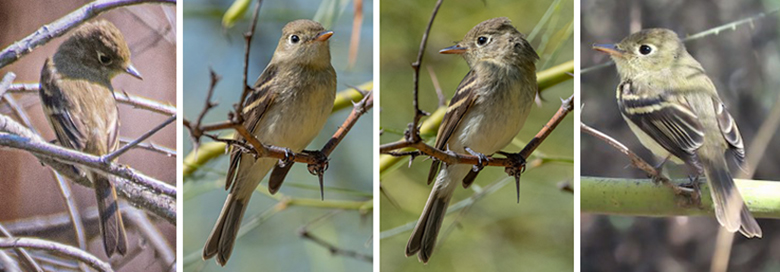
Pacific Slope Flycatchers © James Kendall and Lena Hayashi, Macaulay Library.
Number observed: 4
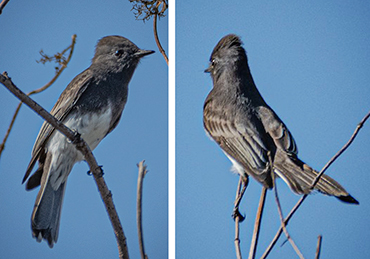
Black Phoebe. © James Kendall, Macaulay Library

Mockingbird. © Lena Hayashi, Macaulay Library

American Goldfinch, Lesser Goldfinch and House Finch. © James Kendall, Macaulay Library
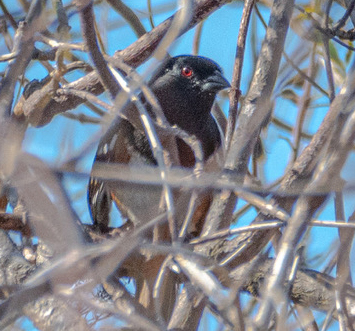
Spotted Towhee. © James Kendall, Macaulay Library
Number observed: 3
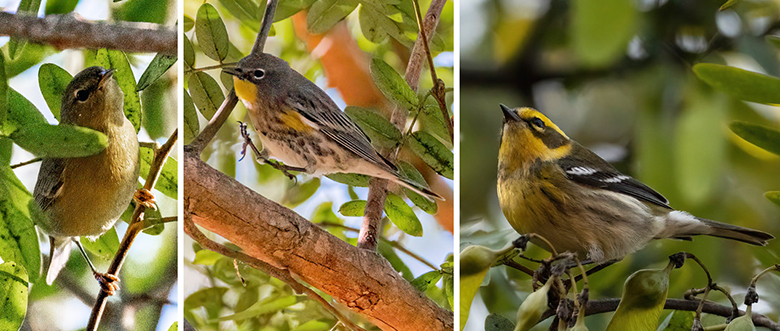
L to R: Orange-crowned Warbler, Yellow-rumped Warbler and Townsend’s Warbler. © James Kendall, Macaulay Library
Western Tanager
Number observed: 2
___________________________________________________________________
August 27, 2021 Survey Results
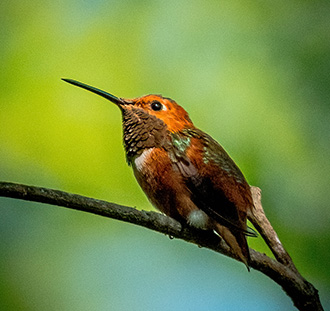
Allen’s Hummingbird. Photo by James Kendall.
Number observed: 3
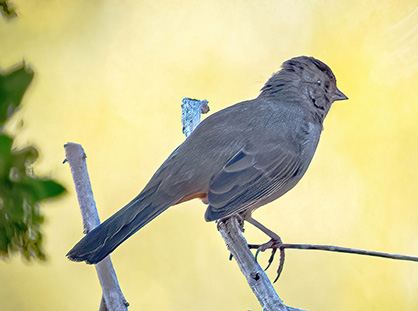
California Towhee. Photo by James Kendall.
Number observed: 2
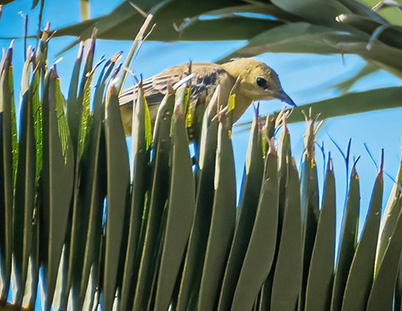 Hooded Orioles. |
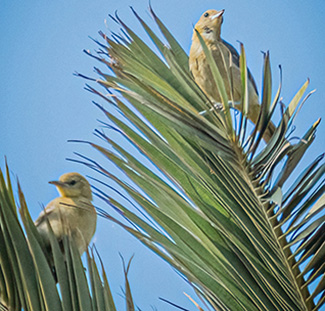 Photos by James Kendall. |
July 29, 2021 Survey Results
Thanks to Dave Telford, Jim Kendall, Betty Kanne, and Jim Currie for coming out this morning to conduct the monthly survey. It was a beautiful morning, clear, calm, in the low 70’s with a light and cool ocean breeze. The begging calls of juvenile songbirds from last month were replaced by immature hawks. Two juvenile Cooper’s Hawks were just outside on a wonderfully placed dead snag in the garden facing the stables and Goldenwest Street. After they called, they flew off, but not before we had the opportunity to take some great photos. Many thanks to the volunteers who created that garden for people and wildlife to enjoy!
Later, as we were walking along the creek paralleling Ellis where the creek makes a 90-degree turn, we heard different hawk sounds in the sycamores. It took some time to find the first juvenile Cooper’s Hawk in the foliage. As we watched its bill, we realized it was not the only one making those sounds. There were a total of three juvenile Cooper’s Hawks!
Hummingbirds were plentiful in the fragrant and beautifully colored butterfly gardens. What a delight it was for us to just stand and watch them feed as they flew from one flower to another. However, there were probably as many Green Fruit Beetles as birds today. They are beautiful too!
– Lena
24 species observed, 212 individuals

© Lena Hayashi Macaulay Library |

© Lena Hayashi Macaulay Library |

© James Kendall Macaulay Library |

© James Kendall Macaulay Library |

© James Kendall Macaulay Library |

© James Kendall Macaulay Library
|
Hummingbird sp.

© Lena Hayashi Macaulay Library |

© James Kendall Macaulay Library
|

© James Kendall Macaulay Library |

© James Kendall Macaulay Library |

© James Kendall Macaulay Library |

© James Kendall Macaulay Library |

© Lena Hayashi Macaulay Library |

© James Kendall Macaulay Library |

Cassin’s/Western Kingbird
___________________________________________________________________
June 24, 2021 Survey Results
It was a beautiful morning–clear, calm and a bit overcast in the early hours, but soon brightened up with sunshine and temperatures in the 60s. Thanks to Dave and Sharon Telford, Jim Kendall, Betty Kanne, and Brenda Sabin for coming out to conduct the monthly survey. Special thanks to Brenda for recording the count on eBird.
We quickly realized our ears needed to tune onto the sounds of recently fledged birds and begging noises of those still needing their parents to feed them. It is nice to know we can now document some of the breeding birds in the Urban Forest. A juvenile California Towhee and a Dark-eyed Junco were seen on the ground within the corralled trees on top of the hill. Young Orange-crowned Warblers were on the branches, fluttering their wings and begging for food. Small flocks of House Finches were doing the same as were the Lesser and American Goldfinches and Bushtits. The nest boxes were all quiet but we are quite sure the Western Bluebirds and House Wrens were successful breeders. Perhaps some are working on a second clutch. Of note, the Lawrence’s Goldfinch was previously documented to have successfully nested in the Urban Forest within the last two months, though we did not see or hear any of them today. Allen’s and Anna’s Hummingbirds are everywhere and definitely nested also.
The Urban Forest is landscaped with all shapes and sizes of vibrantly colored plants in full bloom. We noticed a truckload of trees being planted on the westside hill and look forward to additional habitat and wildlife in the coming years. It’s non-stop work here by the dedicated volunteers. Kudos to them!
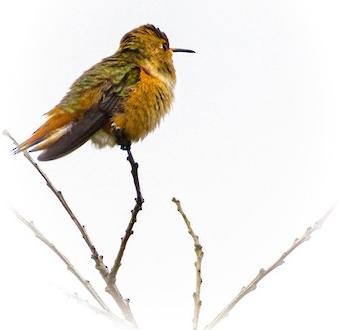
© James Kendall Macaulay Library

© James Kendall Macaulay Library

© James Kendall Macaulay Library

© James Kendall Macaulay Library

© Lena Hayashi Macaulay Library


© James Kendall Macaulay Library

© James Kendall Macaulay Library

© James Kendall Macaulay Library

© James Kendall Macaulay Library

© James Kendall Macaulay Library

© James Kendall Macaulay Library

© James Kendall Macaulay Library

© James Kendall Macaulay Library

Common Yellowthroat
Number observed: 6
___________________________________________________________________
May 27, 2021 Survey Results
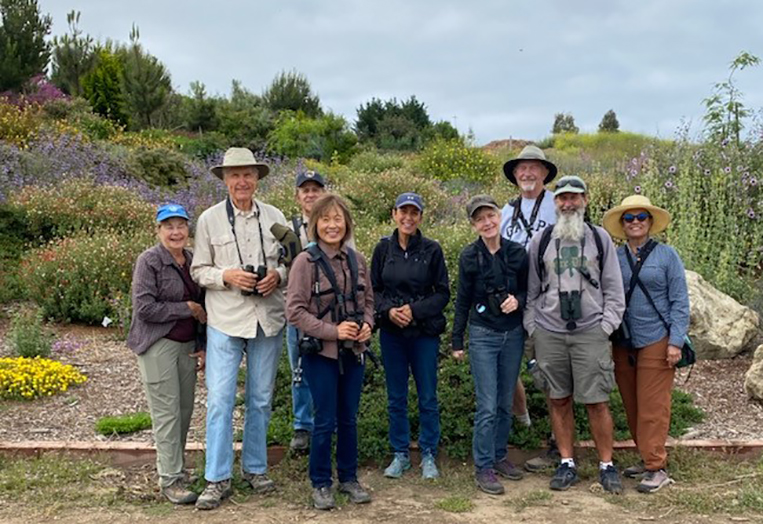
Sharon and Dave Telford, Jim Currie, Lena Hayashi, Barbara Wasbin, Betty Kanne, Jim Kendall, Mark Johnston, and Brenda Sabin, enjoyed a slightly overcast, but pleasant, clear and calm day with temperatures in the 60s when they set out in May to count all the birds they could see and hear.
The majority of migrants have now passed through this part of the Pacific Flyway, as evidenced by the drop in the number of species from last month’s survey high of 48, to 34 this morning. The growth and expansion of habitat in the Urban Forest has provided these birds more acreage to find rest and food sources, and to better ensure their success along their journey to reach their nesting grounds.
For us, now is the time to enjoy the absolutely beautiful blooms of countless plants, flowering shrubs and leafed out trees in the Urban Forest. The forever hard-working volunteers must feel so much satisfaction in seeing the fruits of their labor during this season. The colors are brilliant and the experience enchanting. The surveyors couldn’t be more content while counting and studying the resident and visiting birds of the Urban Forest.
The most vocal nesting birds that can be heard throughout the Urban Forest are the House Wrens, California Towhees, Spotted Towhees, Common Yellowthroats, American and Lesser Goldfinches and the non-native Swinhoe’s White-eyes. A Bushtit, mouth filled with fluff and other nesting material, was seen which means a nest is in the making in a nearby tree. The site of the Lesser Goldfinch nest we saw a female sitting on two months ago is now empty and we hope the chicks fledged successfully. Laura, a UF volunteer, will be happy to know the bluebird box she put up was observed with a male and female Western Bluebird going in and out to feed their young. Many Anna’s and Allen’s Hummingbirds were doing their characteristic mating displays and the sound of hummers flying was everywhere! Flycatchers were plentiful. We had 5 Ash-throated Flycatchers, a Western Wood-Pewee, 4 Pacific-slope Flycatchers, 7 Cassin’s Kingbirds and 5 Western Kingbirds, and 7 of our familiar Black Phoebes. We also had 5 Warbling Vireos and a Cassin’s Vireo.
What a joy it was to walk through the Urban Forest in the spring, to be outside and in nature, and see plants and animals celebrate this time to reproduce and show off their beauty. What could be better? Many thanks to Brenda Sabin for keeping the eBird list, Jim and Dave for their photos, Sheila Holliday for posting the results and list, and of course Jean Nagy and her crew!
– Lena Hayashi
|
Mallard, © James Kendall Macaulay Library |
|
Cooper’s Hawk, © James Kendall Macaulay Library |
Cooper’s Hawk, © James Kendall Macaulay Library |
Red-shouldered Hawk
Number observed: 1
 |
Red-shouldered Hawk, © James Kendall |
 |
Downy Woodpecker
|
Downy Woodpecker, © James Kendall Macaulay Library |
|
House Wren, © James Kendall Macaulay Library |
House Wren, © James Kendall Macaulay Library |
Details: male and female observed entering and exiting box feeding young
|
Western Bluebird, © James Kendall Macaulay Library |
Western Bluebird, © James Kendall Macaulay Library |
Western Bluebird, © Lena Hayashi Macaulay Library |
Details: many including young fledged birds
Details: Fledgling in a small tree during our observation, neither parent came to feed it.
|
American Goldfinch, © James Kendall Macaulay Library |
American Goldfinch, © James Kendall Macaulay Library |
Details: Unusual vocalization – clear, tonal and fairly long whistle-like note followed by usual pweee ending. Initially thought it was from two different birds but when it flew away, it continued with the two sounds from another location. Syrinx capable of two sounds almost simultaneously.
___________________________________________________________________
April 29, 2021 Survey Results
It was a beautiful sunny, clear, and calm morning with the temperature in the 60s when Lena Hayashi, Jim Kendall, Betty Kanne, Brenda Sabin, Ellen Tipping, Ellyn Siskind, Barbara Wasbin, Mark Johnston, and Jim Currie began, and around 72 when we finished. We were all anxious to see what birds would be seen during this best month for spring migration. We were not disappointed. We had 349 individual birds and 48 species!
We decided to go together as one group directly to the top of the Urban Forest so we could enjoy the expected migrants around the wonderfully shaded area around the corralled trees. After spending two hours there, we divided into two groups and birded another hour along the more open-spaced grassy areas along Goldenwest and Edwards.
It was like being in a candy store for birders! We were sweetly surprised and delighted with sightings everywhere. We had 2 Hermit Warblers, a Townsend’s, 3 Black-throated Grays, and 6 Wilson’s Warblers on their way north to nest in our western states, Canada and beyond. Our resident and nesting warblers, Orange-crowned and Common Yellowthroat were singing their songs in the hope of attracting mates.
Though towhees are usually found on the ground foraging, the California and Spotted were both high off the ground to broadcast their songs more efficiently. This is when it is easy to confuse the Black-head Grosbeaks with the Spotted Towhees as their coloring is so similar.
A Bushtit, mouth filled with fluff and other nesting material, was seen which means a nest is in the making in a nearby tree. The site of the Lesser Goldfinch nest we saw last month seemed to still be active. Laura, a UF volunteer, will be happy to know the bluebird box she put up was observed with a male Western Bluebird hanging outside the hole (see photo). Not sure if he was checking out the box of if a female was inside. Both Anna’s and Allen’s Hummingbirds were each doing their characteristic mating displays and the sound of hummers flying was everywhere! Flycatchers were plentiful. We had 5 Ash-throated Flycatchers, a Western Wood-Pewee, 4 Pacific-slope Flycatchers, 7 Cassin’s Kingbirds and 5 Western Kingbirds, and 7 of our familiar Black Phoebes. We also had 5 Warbling Vireos and a Cassin’s Vireo.
What a joy it is to walk through the Urban Forest in the Spring, to be outside and in nature and see plants and animals celebrate this time to reproduce and show off their beauty. What could be better? It is fabulously beautiful for the visitors and it must be so rewarding for all the volunteers to reap what they worked so hard to sow. Many thanks to Jean Nagy and all the volunteers!
Mallard
Number observed: 6
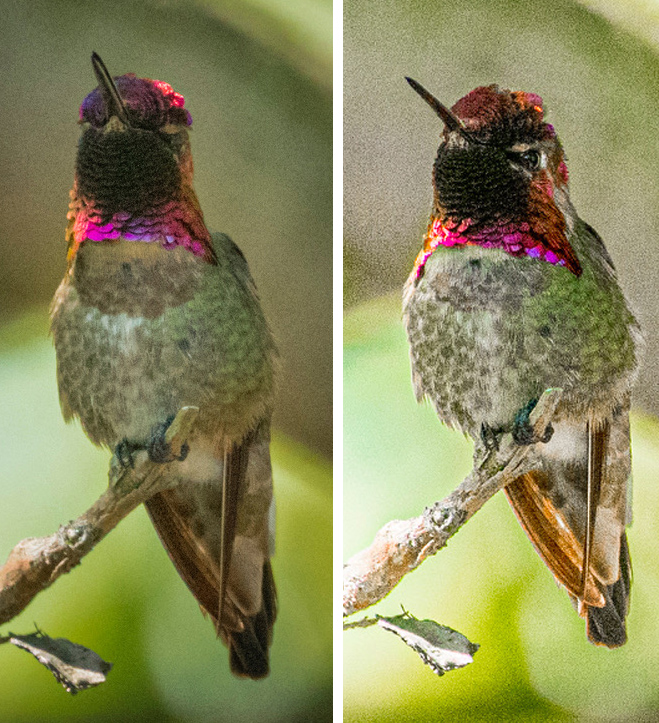
Anna’s Hummingbird, © James Kendall Macaulay Library

Western Wood-Pewee, © James Kendall Macaulay Library
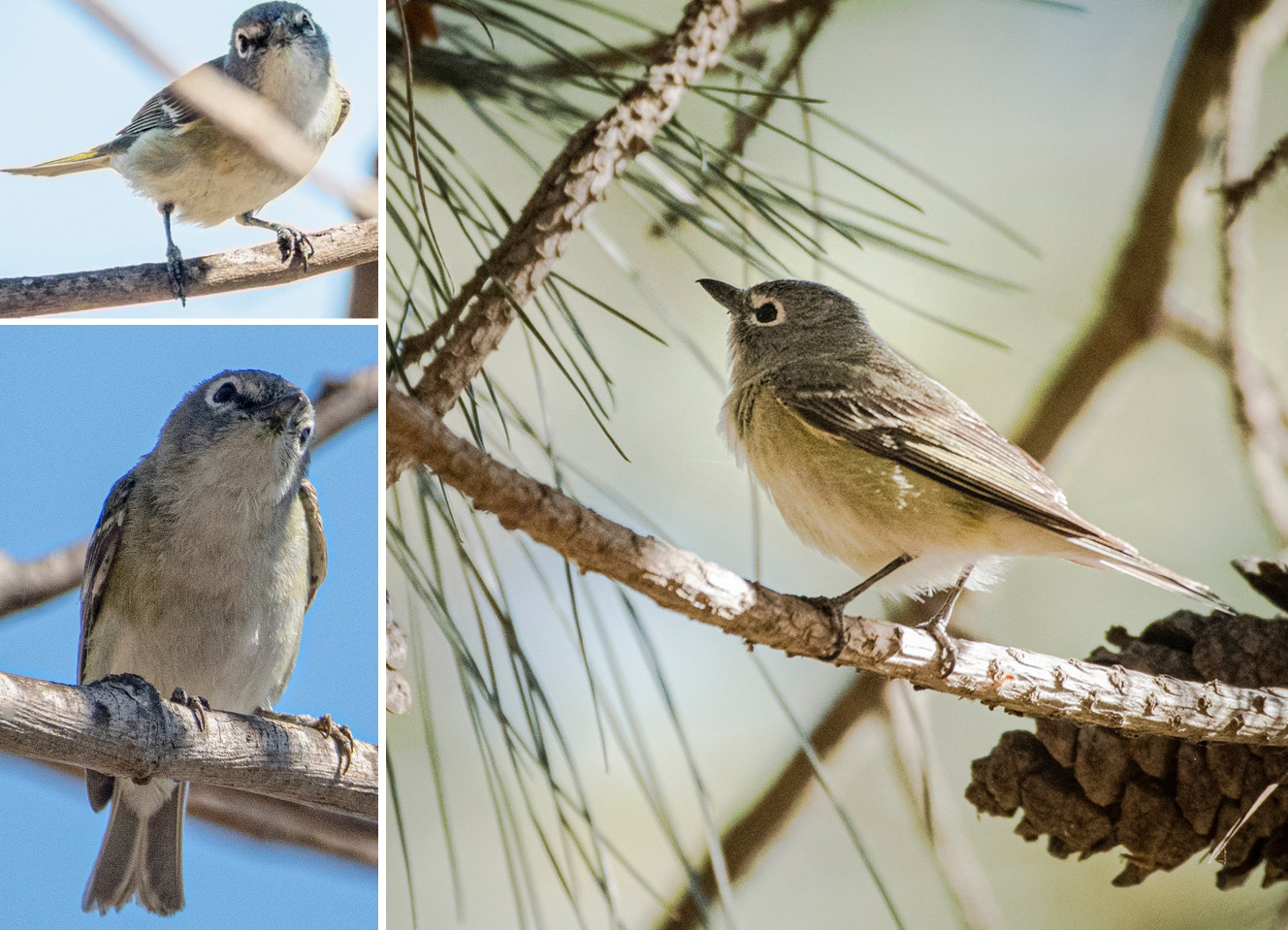
Cassin’s Vireo, © James Kendall Macaulay Library
Swallow – species unidentified

Western Bluebird, @Lena Hayashi Macaulay Library
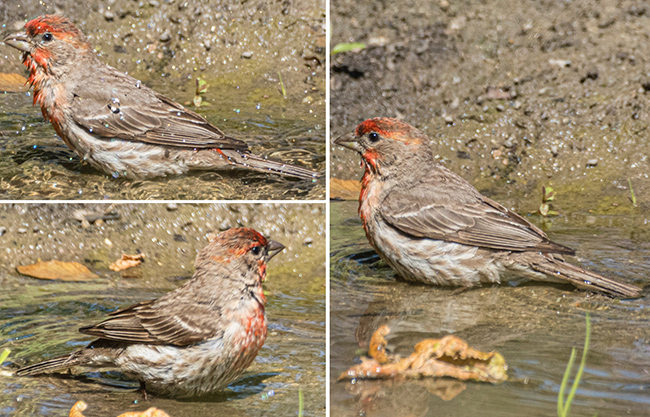
House Finch, © James Kendall Macaulay Library

Black-throated Gray Warbler, © James Kendall Macaulay Library
___________________________________________________________________
March 25, 2021 Survey Results
Details: mostly flying over in twos
Details: heading to stables
Details: some displaying for a mate
Details: some displaying for a mate
Details:flyovers
Details: flyover
Details: flyover
Details: on a telephone pole just outside UF on Edwards
Details: singing

© Lena Hayashi Macaulay Library

© Lena Hayashi Macaulay Library
Details: singing
Details:two pairs
Details: one within wooden fenced forest

© Lena Hayashi Macaulay Library
Details: nest found in young pine tree with female on nest and male feeding her
Details: many on higher branches but not singing
___________________________________________________________________
February 25, 2021 Survey Results
Despite an ominous forecast of very high winds, four birders came out for this month’s survey. Fortunately, the winds were not nearly as high as predicted, the temperature ranged from 55 to 70 degrees, and we were able to observe 35 species and 275 birds.
duck sp.

© James Kendall Macaulay Library

Number observed: 7
 |
 |
Number observed: 10
 © Lena Hayashi Macaulay Library © Lena Hayashi Macaulay Library |
 © James Kendall Macaulay Library © James Kendall Macaulay Library |
 © James Kendall Macaulay Library © James Kendall Macaulay Library |

 © James Kendall Macaulay Library |
 © James Kendall Macaulay Library |
 © James Kendall Macaulay Library
|

Details: One seen on Goldenwest Street-side, high up on top of dead eucalyptus alone. Others seen on Edward’s side. Singing.
|
© James Kendall Macaulay Library |
 |
___________________________________________________________________
January 28, 2021 Survey Results
This Thursday was a cool, sunny, clear, calm 50 degrees. Observations of 32 species and 353 individuals were conducted by Lena Hayashi with Ellen Tipping (ebird), Jim Kendall, Betty Kanne, Jim Currie, Dave and Sharon Tellford. The birders were grateful to be able to survey before the big rain began that evening.
Canada Goose
Number observed: 2



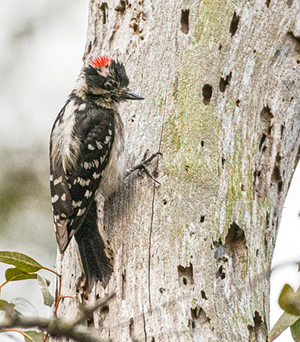
Male woodpecker © James Kendall Macaulay Library
Two males, one with orange and white band. One female.








___________________________________________________________________
December 31, 2020 Survey Results:
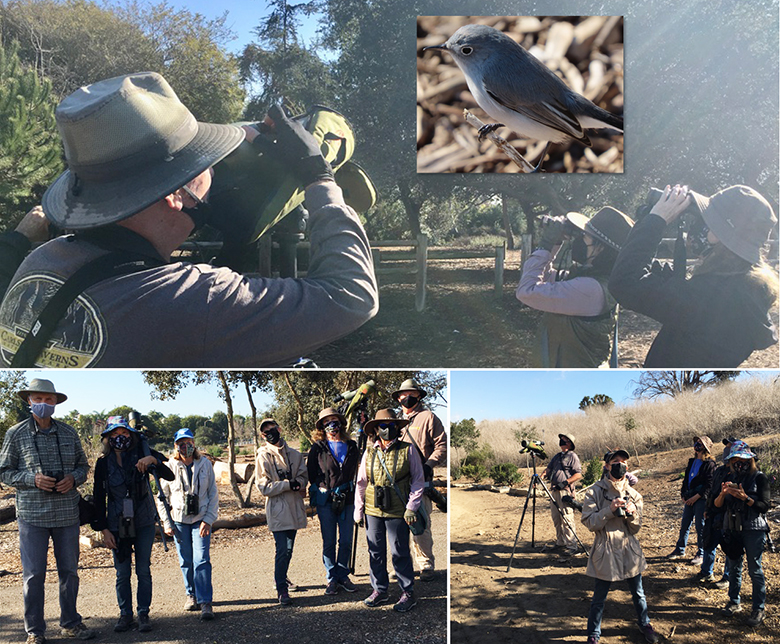
Among the many birds observed on New Year’s Eve 2020 was this Blue-gray Gnatcatcher, photographed by Birder Lena Hayashi.
In 3 hours and 36 minutes on a calm, 48-62 degree New Year’s Eve day, 9 birders observed 36 species and 382 birds. Birders were delighted to meet Jack, an 11-year-old HB Tree Society volunteer who joined them for awhile. One birder loaned him binoculars and all of them took Jack under their wings. Jack learned quickly how to use the face of a clock to direct observers to where he was seeing a bird. He is a natural!
Details: 3 female 1 male


Details: All found in Sycamores feeding on seed pods along creek where it parallels Goldenwest toward the Equestrian Center.
Details: In open fields on Edwards side
Details: In Oaks and Tipu trees on top of the Urban Forest
____________________________________________________________________________________________
November 26, 2020 Survey Results:
Eight birders spent 3 hours and 7 minutes on this month’s survey on a 54-60 degree, sunny, calm, clear day. There were 36 species observed (331 individuals).
Details: Mating display
Details: Mating display


Details: Flyover




Nuttall’s Woodpecker













Details: Varying numbers, several flocks. At least one flock of 15 or so.
Details: Many seen and heard
Details: Male and female seen
Details: Chucking and vree whistling throughout morning


Details: Most seen in Sycamores along the bend of the creek paralleling Goldenwest









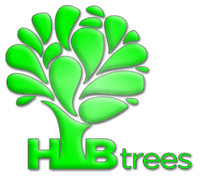






















































































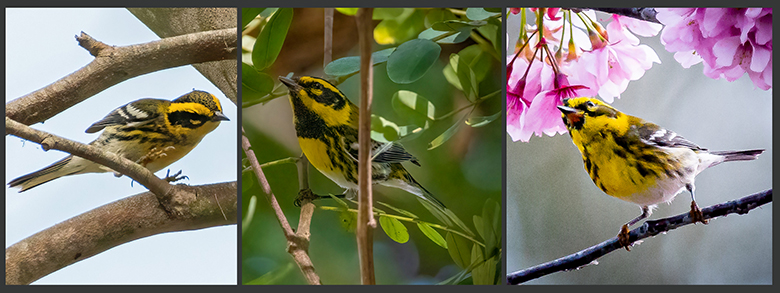























































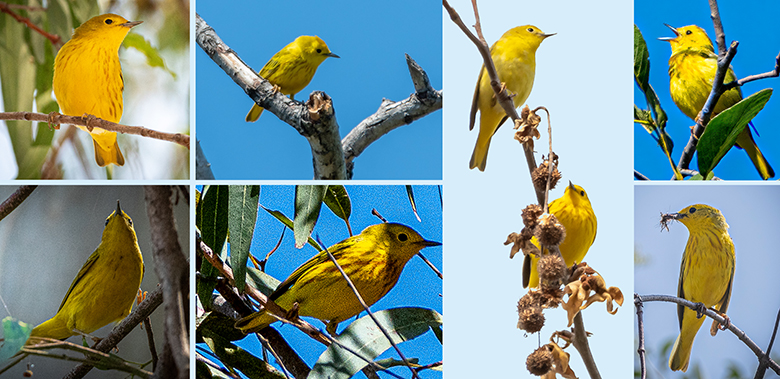
























































































































































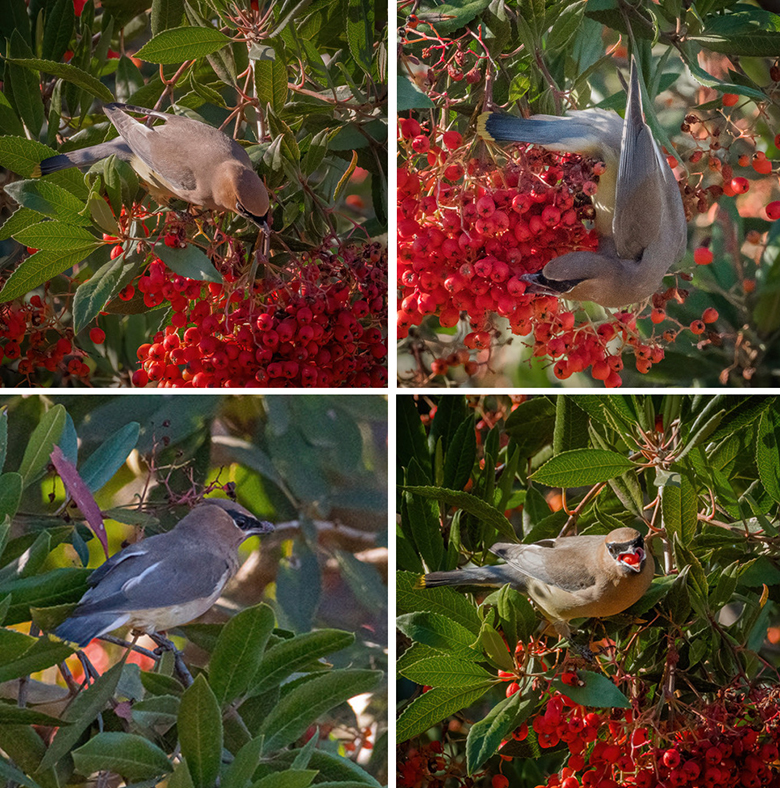
















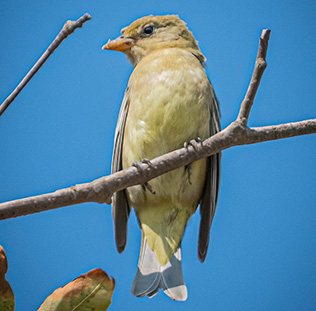
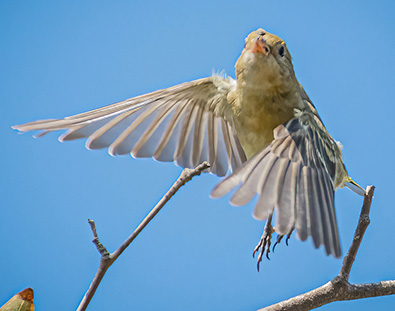








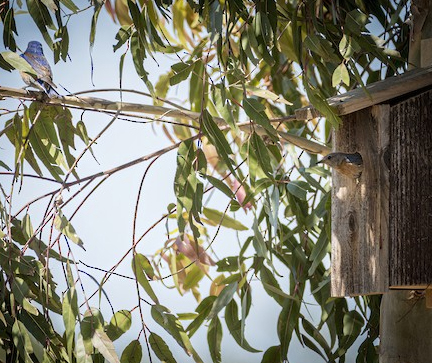
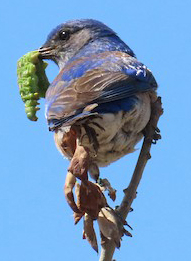





Details
In stables